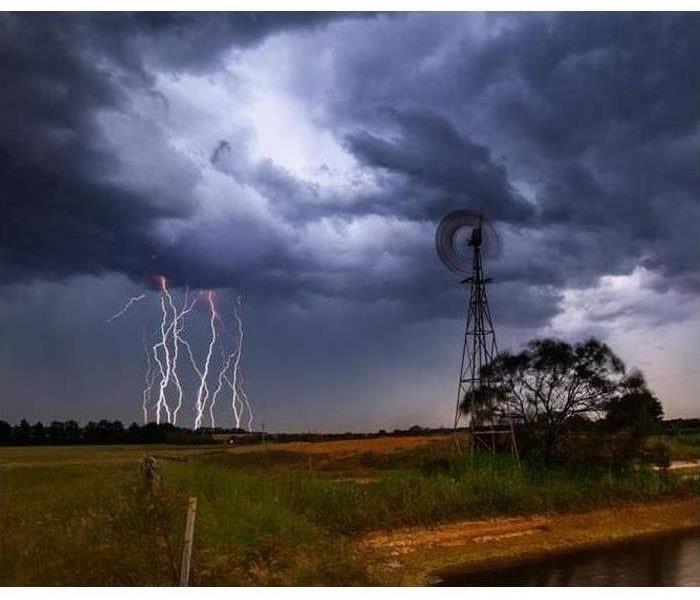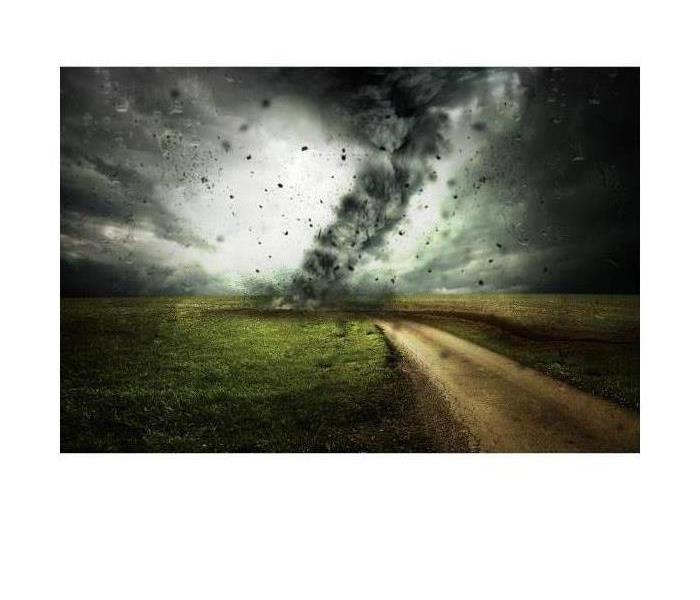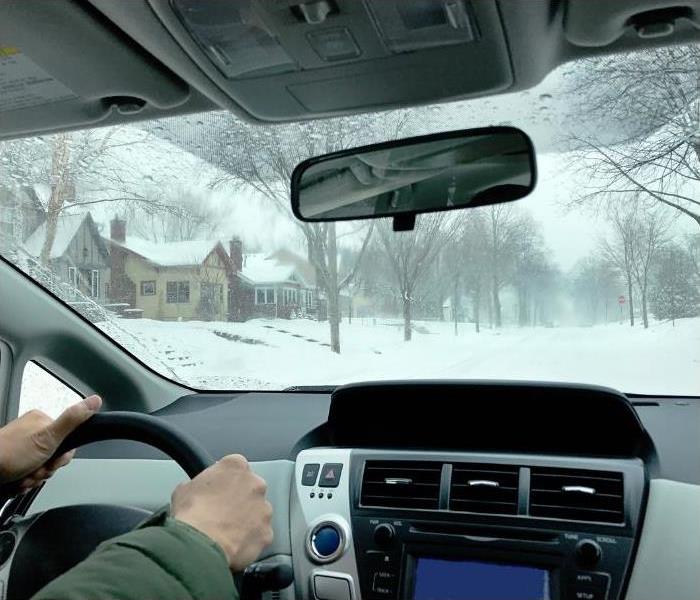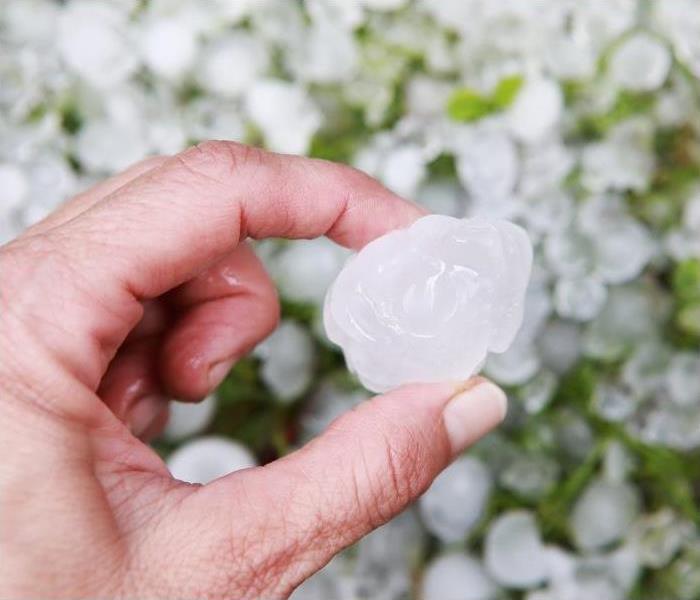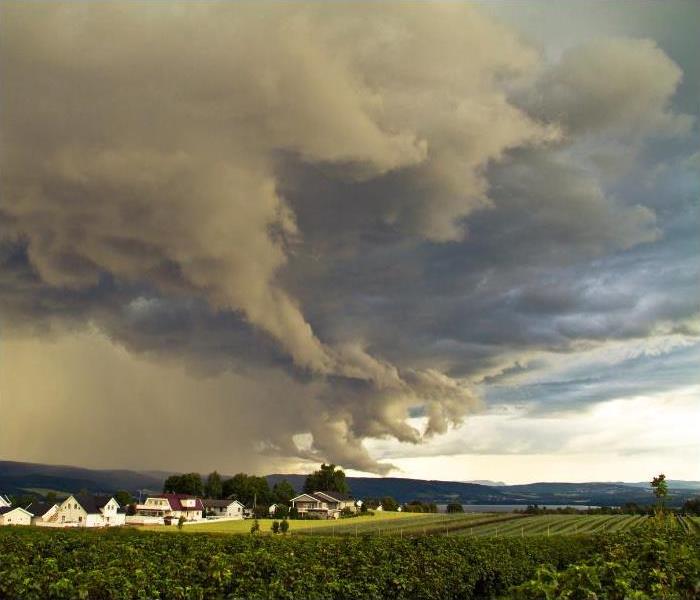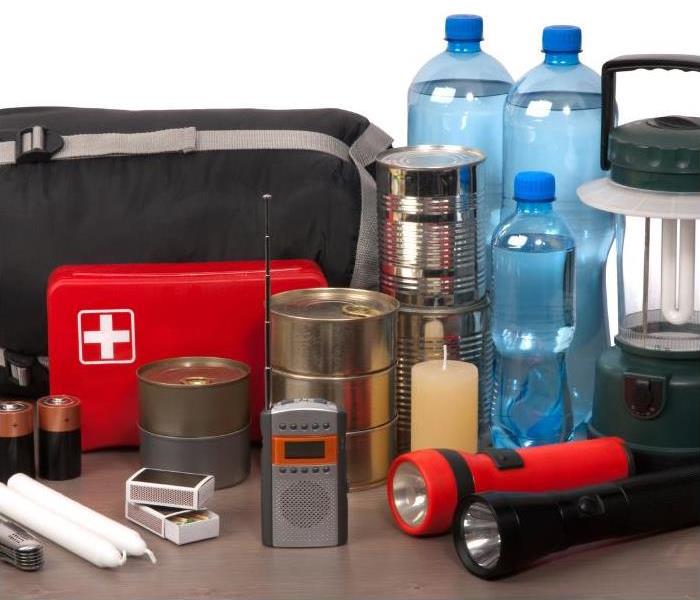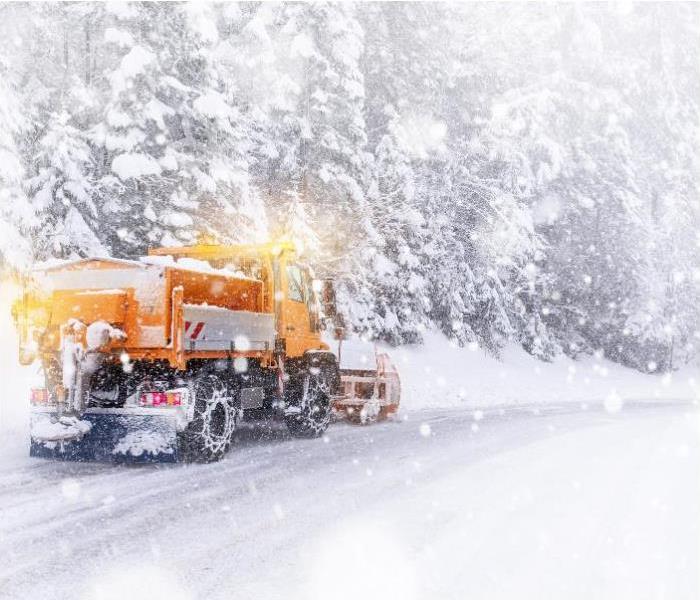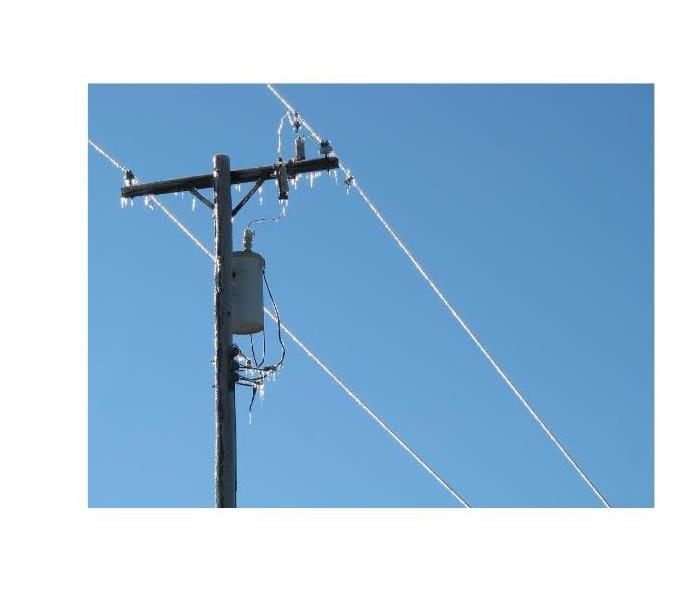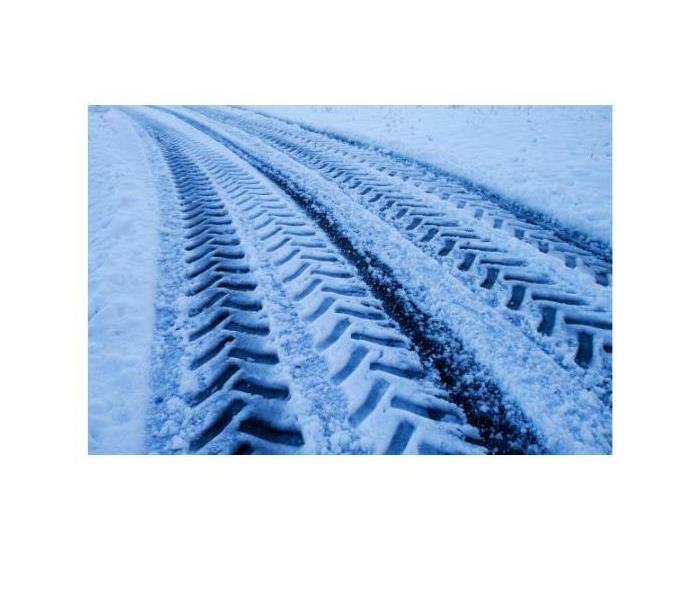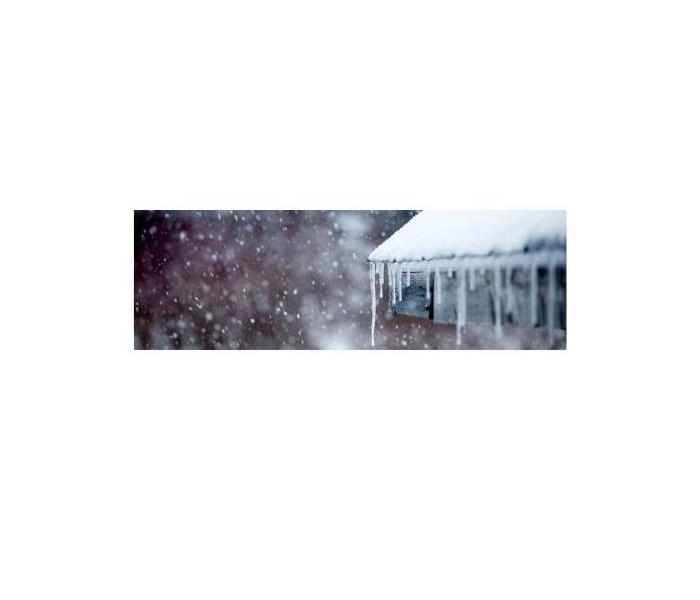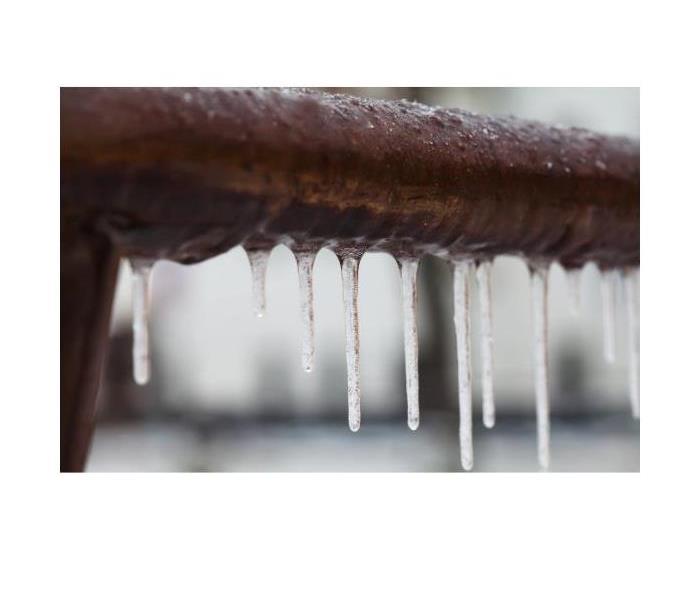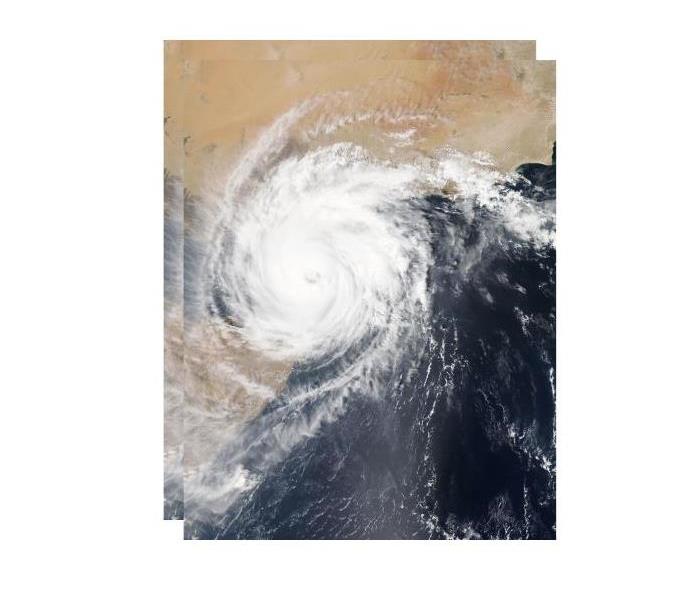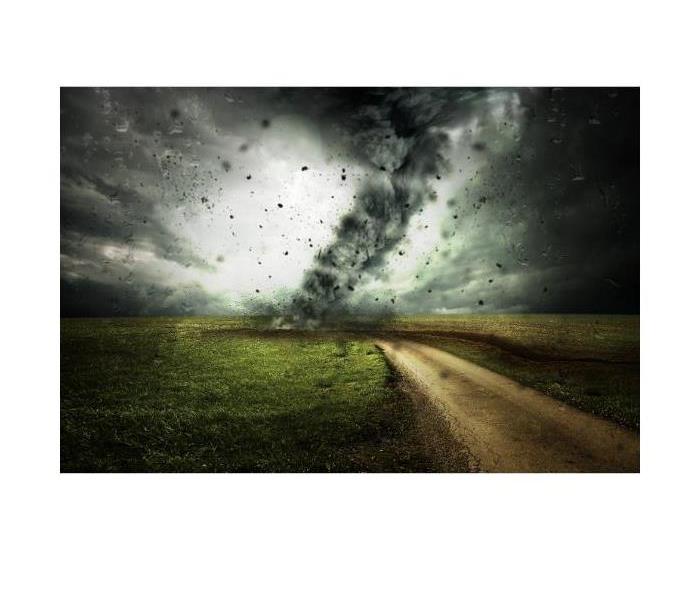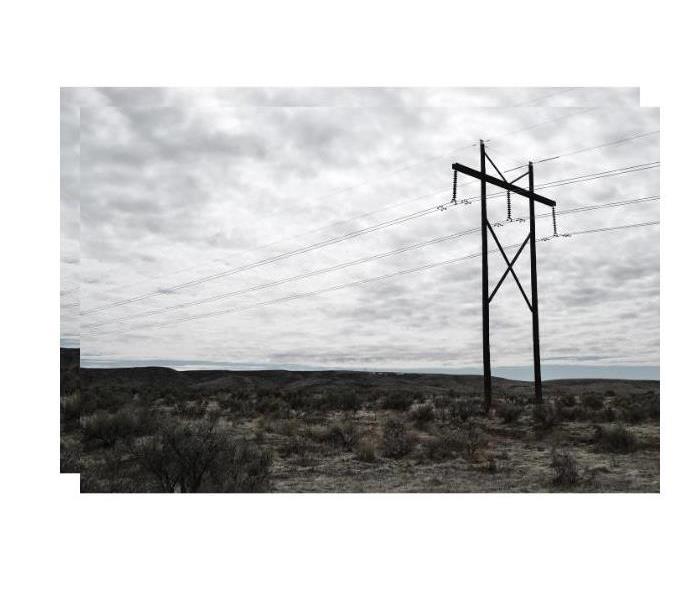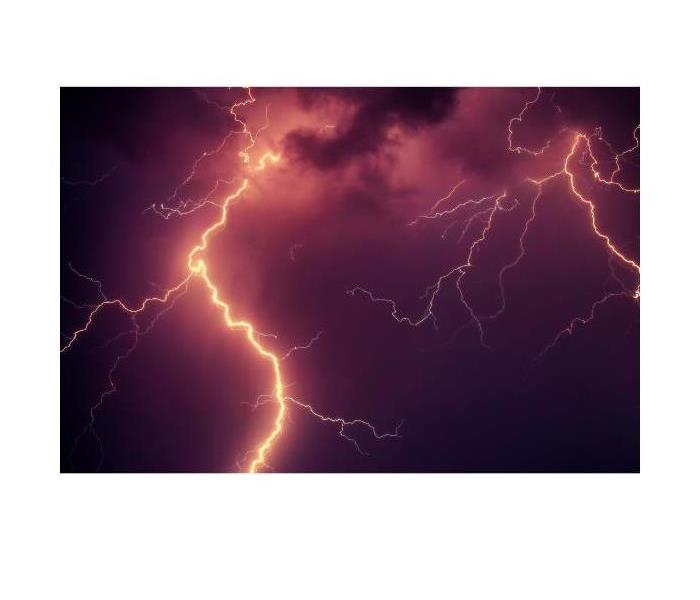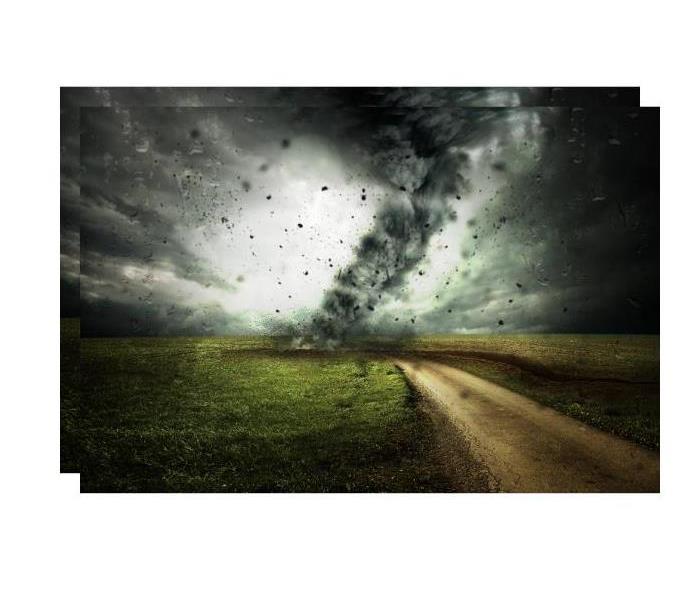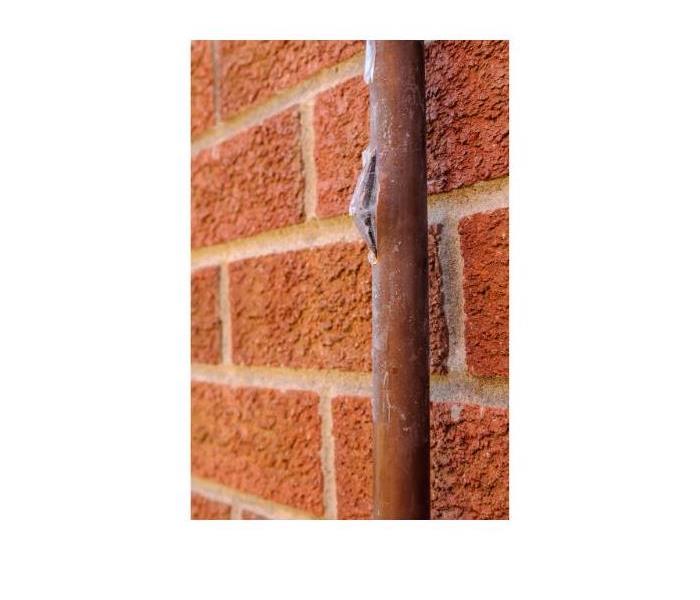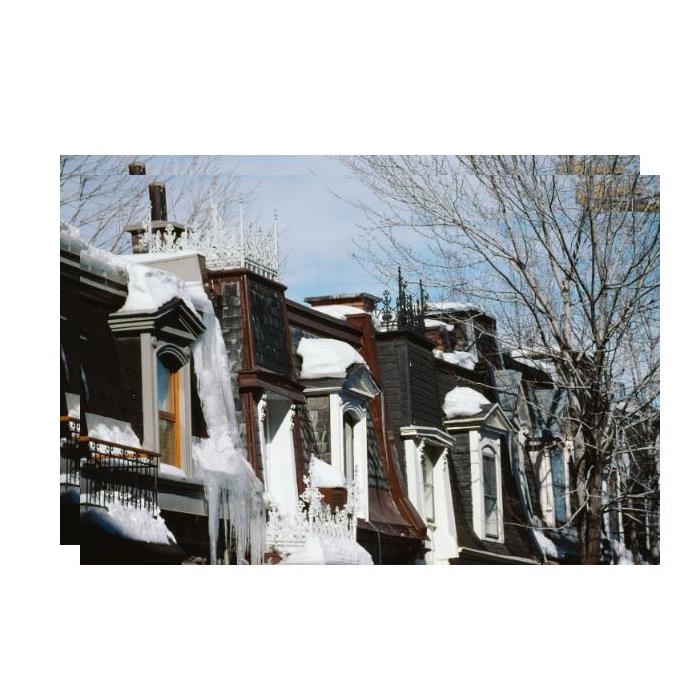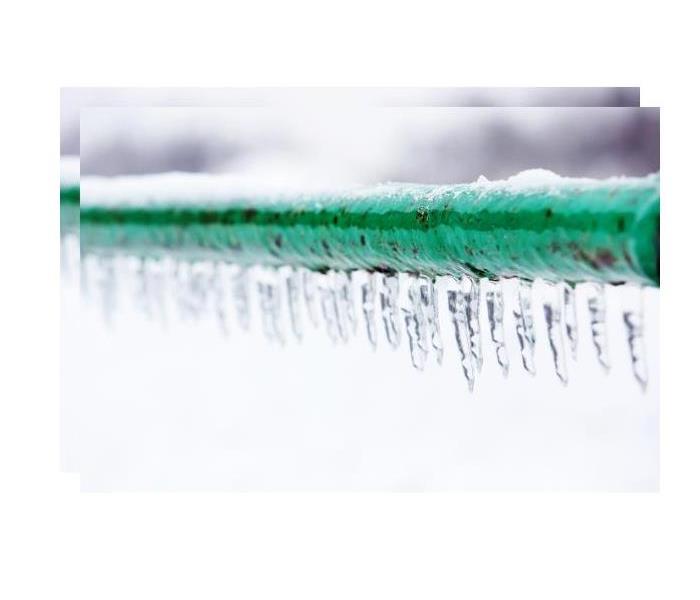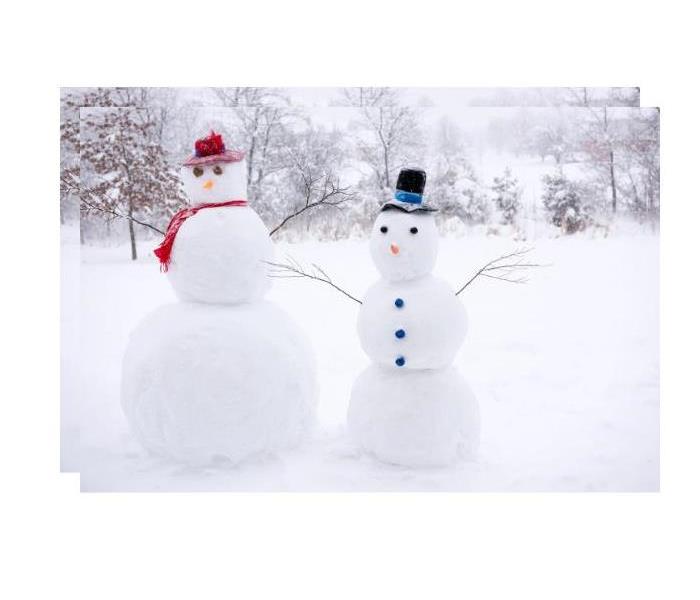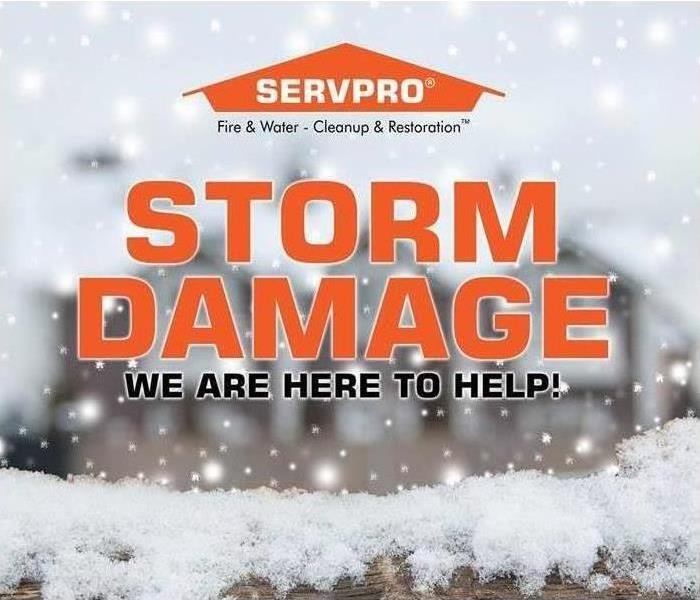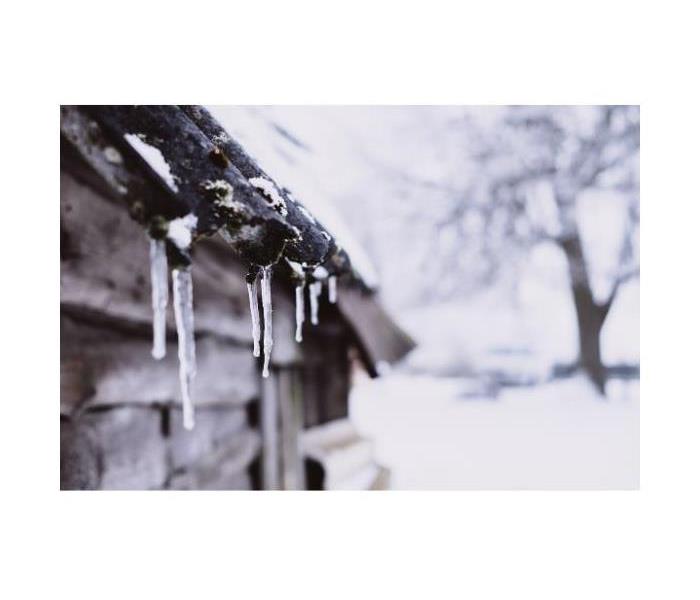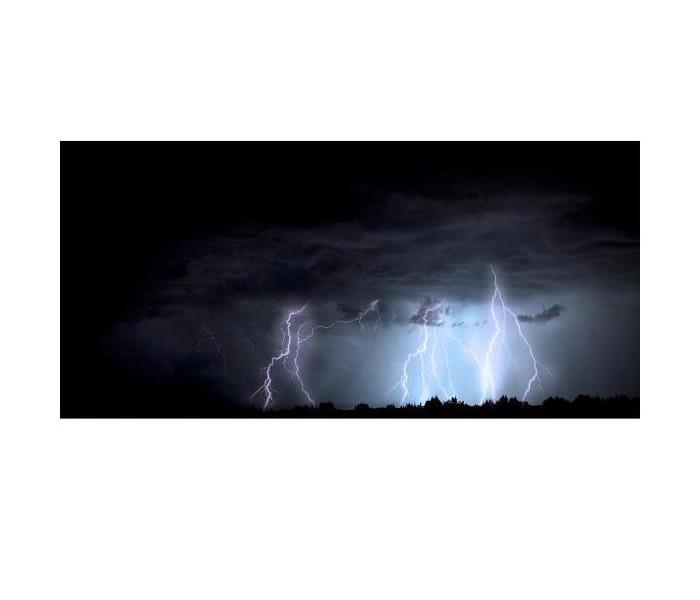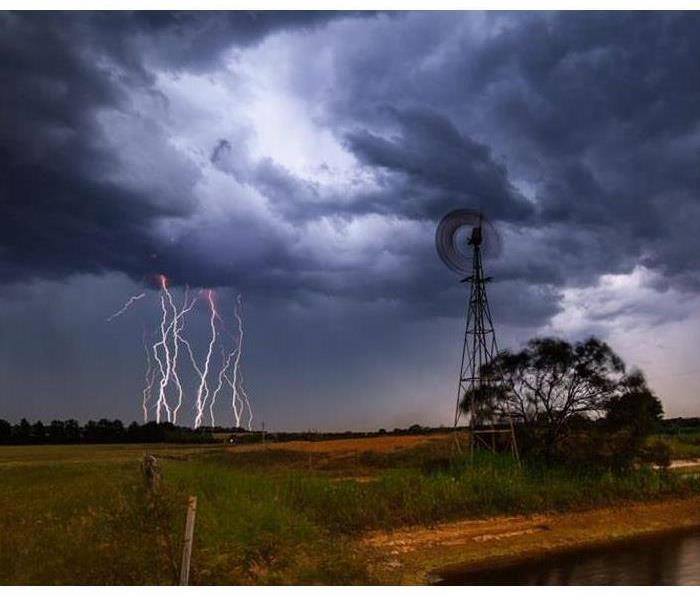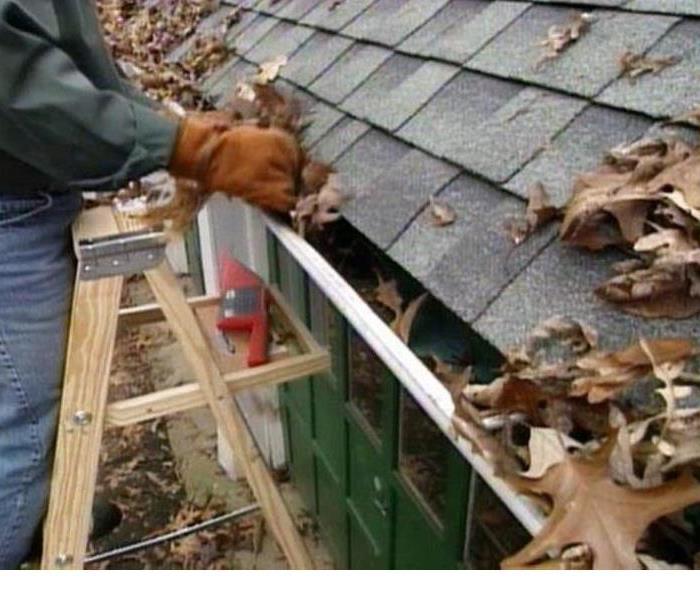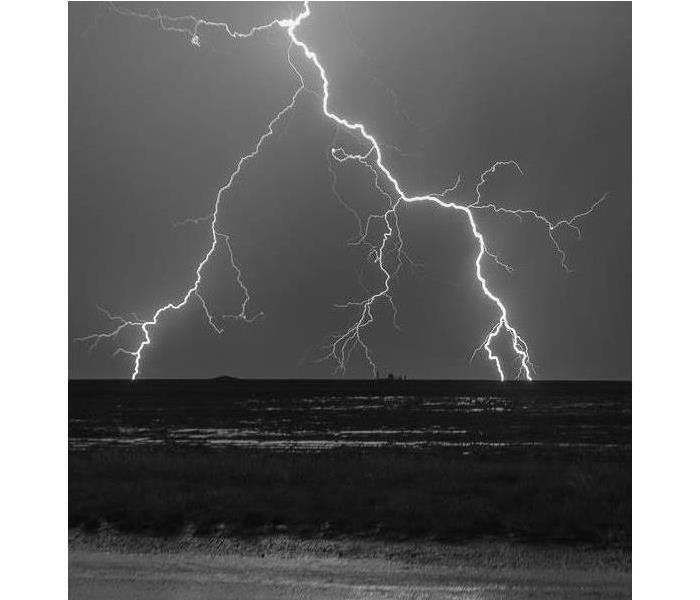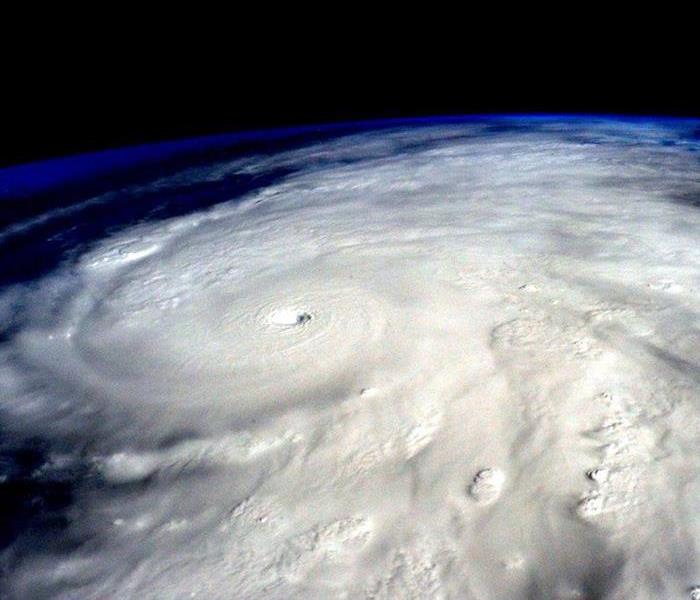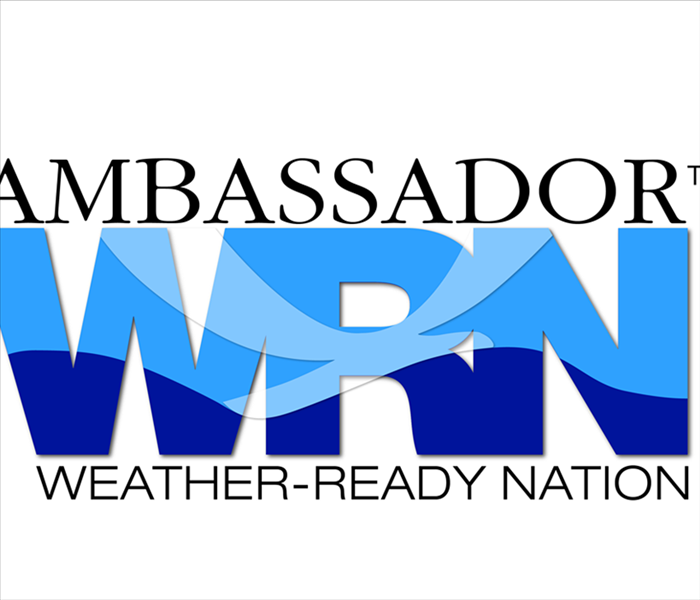Recent Storm Damage Posts
When Storms Hit, We Are READY!!
8/1/2024 (Permalink)
Storm and flood damage require specialized restoration techniques and equipment. Lucky for you, the staff here at SERVPRO of Springfield and Sangamon, Morgan, Cass, Macoupin, Montgomery Counties have both! Since we are locally owned and operated and open 24/7, we can respond quickly which is key. A faster response can limit damage and save you in the long run. Let us make it "Like it never even happened." Contact us for any of your storm damage needs at 217-528-7775.
Tornado Safety Tips
6/2/2023 (Permalink)
If you live in the midwest, you have most likely experienced a tornado in your general area. If you have not, consider yourself lucky. Here in central Illinois, we have had some major damage done to some of our cities that take months or years to recover. The last tornado in our area that caused extensive damage was in Taylorville in 2018. We are incredibly thankful we did not have any major injuries or deaths but we did experience some major structural damage to many homes, personal property, and businesses. SERVPRO was proud to be a leader in restoration during that time of need. Tornadoes are difficult to prepare for because many times we don’t have a lot of notice. What we can do is be prepared as possible ahead of time. We have put together some potentially life saving tips for you and your family to read over and take action.
- Have a Plan. If you have a basement, please use it. If you do not have a basement or lower level, go to an interior room with no windows or outside doors. Using a mattress to cover your head and body from debris is recommended, if you do not have a mattress, use a blanket, if that is not available, use your arms to protect your head from possible flying debris. It’s also recommended to have an emergency kit with enough supplies to provide for your family for 72 hours.
- Practice your Plan. Having a plan at home is great but if no one in your family is aware, it’s useless. Be sure to practice your plan using different times of day and while your family is in different areas of the home. Be sure they are aware of the safest areas of your home and the least safest. Explain to small children why it’s so important to be away from windows and doors and the importance of being face down and covering their heads because of flying debris.
- Talk with your children about their plan at school as well. Again, reiterate the importance of positioning. Communication and practice will help your child to feel more secure and confident in a time of crisis.
- Do not bother with your windows. It’s been said to raise windows in order to equalize pressure in your home during a tornado. This is a myth. The fact is if there is a tornado over your home, it’s likely the windows will be blown out anyway so let’s make sure you are nowhere near them. Please do not bother with the windows at all and go straight to your safe room and take cover.
- Know the sounds and alerts. Make yourself and your family aware of what the tornado siren sounds like in your community. Watch your local news or listen to your local radio. They will likely be keeping you updated on locations and recommending actions to keep you and your family safe.
I have copied the definitions for both tornado warning and tornado watch directly from the National Weather Service website; weather.gov
- Tornado Watch: Be Prepared! Tornadoes are possible in and near the watch area. Review and discuss your emergency plans and check supplies and your safe room. Be ready to act quickly if a warning is issued or you suspect a tornado is approaching. Acting early helps to save lives! Watches are issued by the storm prediction center for counties where tornadoes may occur. The watch area is typically large, covering numerous counties or even states.
- Tornado Warning: Take Action! A tornado has been sighted or indicated by weather radar. There is imminent danger to life and property. Move to an interior room on the lowest floor of a sturdy building. Avoid windows. If in a mobile home, a vehicle, or outdoors, move to the closest substantial shelter and protect yourself from flying debris. Warnings are issued by your local forecast office. Warnings typically encompass a much smaller area (around the size of a city or small county) that may be impacted by a tornado identified by a forecaster on radar or by a trained spotter/law enforcement who is watching the storm.
- If you are driving and can find a shelter inside a building, that is best. If there are absolutely no buildings in your area to seek shelter, you should look for the lowest possible land and lie on your stomach covering your head with your arms. If there is no low lying land, your last option would be to remain in your car with your seat belt on crouching as low as your can under the windows covering your head. Using a blanket or any material to cover your face and head to protect yourself from flying debris. Do not shelter under a bridge or overpass.
SERVPRO of Springfield, we are your restoration experts. We are Here to Help you and your family through any disaster.
As always, if disaster strikes, SERVPRO of Springfield, Morgan, Cass, and Montgomery counties is always here for you. We can be reached 24/7 at 217-528-7775.
Snacking in the Rain
10/3/2022 (Permalink)
 Rain Snacks
Rain Snacks
When the rain is pouring down outside, the traditional snack runs that we take with our family, like a trip to the ice cream shop or to get a snack from a food truck, are not as much fun. But if your family is simply dying to have a tasty treat while it’s raining, there are many creative at-home recipes that will please everyone in the family, and also make a fun activity in the preparation. Taste of Home.com has a list of creative snack ideas that any family will find absolutely delicious.
- Rainbow Cake with Clouds
- A bright Rainbow Jello Cake using a little whipped cream on the side to make fluffy clouds
- Waffle-Iron Pizzas
- Dough and your favorite toppings, or even breakfast fillings like ham and eggs, get cooked and pressed in the waffle iron to create delicious mini pizzas
- S'mookies
- Replace the gram cracker in a s'more with cookie dough and bake the whole thing
- Frozen Banana Cereal Pops
- Dip bananas in yogurt, roll 'em in cereal, then freeze
- PBJ on a Stick
- Take the classic peanut butter and jelly sandwich on the go with skewers
- Peanut Butter Chocolate Poke Cake
- Chocolate cake combined with creamy peanut butter and topped with peanut butter-filled sandwich cookies and peanut butter cups
- Hot Dog Roll-Ups
- Cheese-and-bacon-filled hot dogs wrapped in a fluffy croissant
- Cereal & Milk Ice Cream Sandwiches
- Sugary cereals and treats are all frozen together to make ice cream sandwiches
- Pizza Monkey Bread
- Tomato sauce, cheese, and any pizza toppings you want all wrapped up in a sweet monkey bread crust
- Kiddie Crunch Mix
- A no-bake snack mix is a delightful treat for kids, and you can easily increase the amount to fit your needs
With a little creativity and ingenuity, your family can have a good time cooking up some unique snacks that also happen to taste delicious. And most are snacks that you can create using the everyday grocery items that you probably have around your house. And you can even try inventing your own recipes. So give it a try the next time you’re stuck inside with the rain and see what delicious treats you can create.
As always, if disaster strikes, SERVPRO of Springfield and SERVPRO of Morgan, Cass, Macoupin & Montgomery Counties are always here for you. We can be reached 24/7 at 217-528-7775.
How the Heck do you Read a Weather Radar?
9/4/2022 (Permalink)
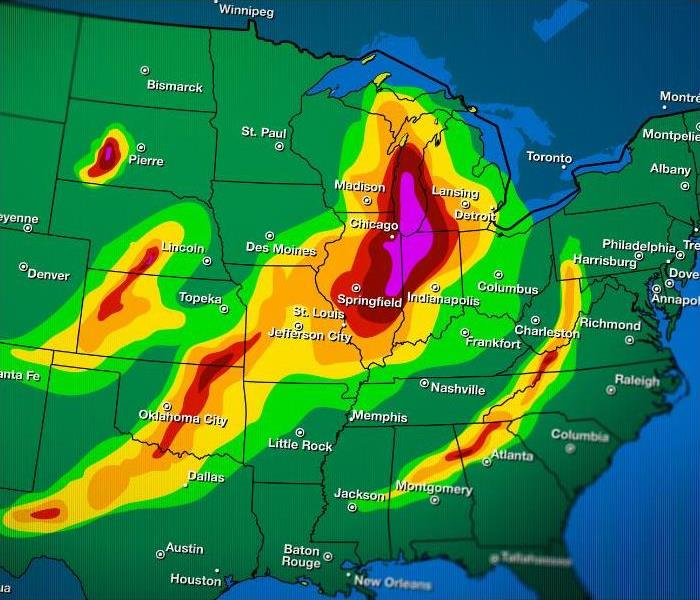 Weather Radar
Weather Radar
The weather radar we see on the local weather forecasts can be confusing. You have to know the key colors, make sure you’re looking at the future forecast, and take it with a grain of salt because it could be wrong entirely. And if you’re watching it on your local news it can be even harder with the weatherman’s explanations playing at the same time. All this when all you really want to know is whether or not you need to bring an umbrella to work today or not. It’s much easier to know what’s coming if you can read the radar for yourself. The people at Outside magazine have some tips on how to read weather radar like a pro;
- Look at more than just precipitation
- Know what's going on inside a storm
- Recognize the limits of radar
- Get the best radar app for your area
- Most color scales are simple rainbows, warmer colors indicate heavier precipitation
- By using the Doppler effect to measure how fast and in which direction rain, hail, and snow are moving, it can accurately tell us the wind speed and direction of a storm
- Velocity imagery is almost always displayed with red and green colors
- You can spot rotation and a possible tornado in a thunderstorm by looking for strong winds blowing in different directions right next to each other
- Bright colors all moving in one direction are a sign of damaging straight-line winds
- Mountains are a significant barrier to radar use in the western United States
It’s no secret that weather is a very fluid event each and every day. One day you can be enjoying a warm and sunny day, and then the very next it can be windy with clouds and freezing cold temperatures. Sometimes both extremes can show up in a single day. And while weathermen do the best they can to predict, sometimes weather will do whatever it wants. So take some time to familiarize yourself with the symbols and colors on the weather radar so you can know whether or not to bring that umbrella today.
As always, if disaster strikes, SERVPRO of Springfield and SERVPRO of Morgan, Cass, Macoupin & Montgomery Counties are always here for you. We can be reached 24/7 at 217-528-7775.
Sandstorms on Rampage
8/4/2022 (Permalink)
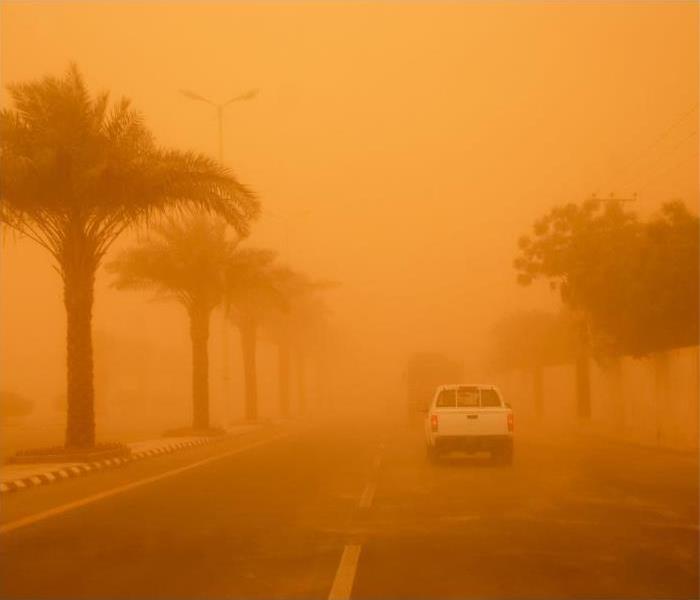 Sandstorm
Sandstorm
A sandstorm is a very unique weather event. It’s one of the few weather phenomena that can only happen in certain areas of the world. In spite of that, with our availability to travel around the world fairly easily, it’s important to know some basic things about sandstorms. Especially if you’re traveling to a region where they are able to occur. The Wadi Rum Nomads have a list of interesting facts to help understand these crazy events better and protect from them;
- Sandstorms are dry windstorms that blow big clouds of sand in desert regions
- A dust storm is a strong dry wind containing dust-filled air that covers an extensive area during a period of drought over land that is usually arable
- A haboob is a violent, harsh, and dry wind bringing sand and dust from the desert during summer
- Sandstorms are frequent in hot and dry areas across the globe
- Sandstorms arise when the wind is strong enough to airlift the loose top layer of sand and dust from a dry surface
- Most sandstorms arise during the hot and dry summer
- Wind can take them along for thousands of kilometers
- The size of a sandstorm depends on the strength of the wind
- Sandstorms can be so big and thick that you don’t see the sun for days
- Most sandstorms don’t last long and leave as suddenly as they arrived
- Sandstorms move fast as they have wind speeds of at least 40 kilometers per hour
- The quickly reducing visibility is dangerous for people driving
- The sand and dust can get into the eyes, mouth, nose, and lungs, which can cause breathing difficulties and infections
- Using protective eyewear and covering the nose and mouth with a mask or a wet scarf is highly recommended when in danger of a sandstorm
Despite being as dangerous as any other natural disaster, sandstorms can also be an amazing thing to behold. And as long as you take the proper precautions beforehand, you could go and witness one safely from even inside the storm itself. Just make sure if you plan to do that, you know how to protect yourself.
As always, if disaster strikes, SERVPRO of Springfield and SERVPRO of Morgan, Cass, Macoupin & Montgomery Counties are always here for you. We can be reached 24/7 at 217-528-7775.
Summer Scorchers
7/5/2022 (Permalink)
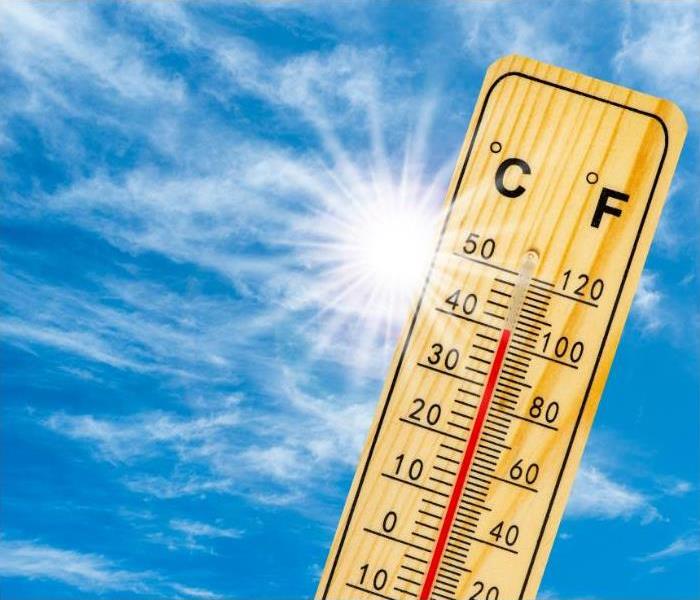 Summer Heat
Summer Heat
Summer dry spells are notorious for causing even those who enjoy the heat to complain. And when they go on for days on end, the complaining only gets louder. But are there more dangers when a summer scorcher comes than just the complaining? Actually, the prolonged summer heat can cause serious problems across the board. The Brain and Spine Foundation has a list of the health problems that can come from being exposed to extreme heat for too long;
- Higher temperatures can stop nerve fibers from working properly
- More easily dehydrated
- More vulnerable to heat rash or eczema
- Higher risk of heat stroke
- Sunburns become a much higher risk
- Underlying health conditions can lower your body’s tolerance to heat
- Certain medicines can cause problems when the body experiences extreme heat
Summer brings a lot of good things with it. No school for the kids, open swimming pools, ice cream, and most of the time, beautiful weather to boot. But in the heat of the summer, that beautiful weather can turn as dangerous as any storm. So it’s important to remember to take breaks and cool down when doing outdoor activities. Always have fun in the summer, just don’t overdo it.
As always, if disaster strikes, SERVPRO of Springfield and SERVPRO of Morgan, Cass, Macoupin & Montgomery Counties are always here for you. We can be reached 24/7 at 217-528-7775.
Hot Air Balloon Safety
6/5/2022 (Permalink)
 Hot Air Balloon
Hot Air Balloon
Hot air balloons are considered by many to be the absolute safest form of air travel. From 2000 to 2016 there were only 21 hot air balloon fatalities. For a vehicle that takes people into the sky that’s highly impressive. But even so, there are still risks involved in flying one. So it’s important to take precautions to make sure that your ride isn’t the one that happens to go wrong. Lerner and Rowe Injury Attorneys has a list of safety precautions you can take to keep yourself safe during a hot air balloon ride;
- Wear warm protective clothing that doesn’t restrict movement
- Wear supportive, close-toed shoes that can help you keep your balance when you land
- Listen carefully to any instructions your pilot gives you before takeoff, during flight, and as you land
- Steadying yourself as the balloon descends and paying attention to your surroundings
- Keep in mind that you may be required to lean or squat to help make for a smooth landing for everyone on board
- The wind can make a hot air balloon ride unpredictable, so always prepare for the worst
There’s a lot of enjoyment that you can get from a hot air balloon ride. It’s very relaxing and fun to be had flying above the world. As long as you’re not afraid of heights that is. But even though hot air balloons are very safe, it’s important to know what you can do to be even safer. So if you have the urge to float high above the ground, make sure you know how to do it safely.
As always, if disaster strikes, SERVPRO of Springfield and SERVPRO of Morgan, Cass, Macoupin & Montgomery Counties are always here for you. We can be reached 24/7 at 217-528-7775.
The Dangers of Dry Lightning
5/3/2022 (Permalink)
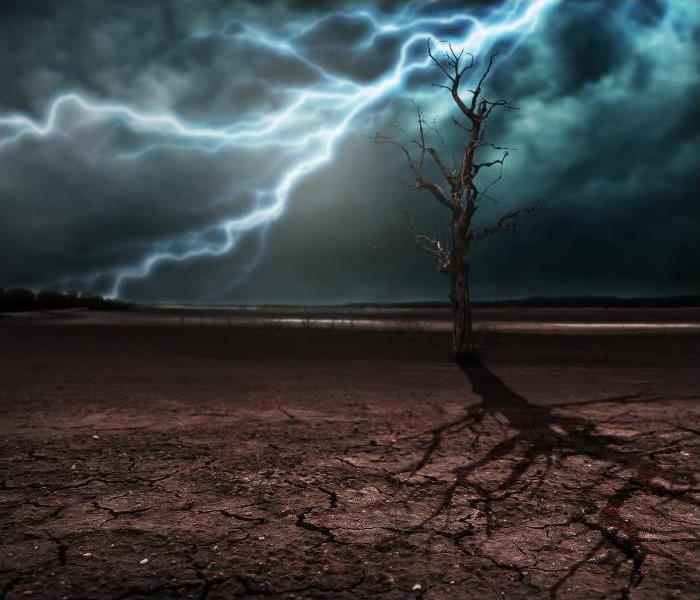 Dry Lightning
Dry Lightning
By its very name, dry lightning seems like an impossibility. The vast majority of lightning is accompanied by a rainstorm of some kind. But also as its name suggests, dry lighting is the exact opposite of its storm counterpart. Dry lightning is cloud-to-ground lightning without any accompanied rainfall nearby. This type of lightning can be even more dangerous because the other signs of a storm, such as rain and wind are not present to provide a natural warning. In response to this unusual phenomenon, The Weather Channel has a list of early warning signs you can use to know when to get to a safe location;
- Dry lightning is most common during the hot summer months
- Upon hearing the sound of thunder, always take shelter whether or not there is any rain
- If you see dark clouds rolling in, be ready to go inside quickly
- Make sure you know the daily forecast so you can be aware of what could be coming and when
- Pay attention to warning sirens and lights
- If the wind picks up significantly, check the sky for dark clouds
Dry lightning is so dangerous because it can strike with far less warning than lightning in a thunderstorm. And its warning signs are equally as subtle if you aren’t looking for them. So it’s critical that whenever you see conditions that are not ideal, you make sure you know what to do should dry lightning become a factor. So, learn the warning signs and be ready if you hear that thunder rumble.
As always, if disaster strikes, SERVPRO of Springfield and SERVPRO of Morgan, Cass, Macoupin & Montgomery Counties are always here for you. We can be reached 24/7 at 217-528-7775.
Slow Down! Icy Roads!
12/2/2021 (Permalink)
With the recent big ice storms, most will avoid the roads as much as they can. But even those currently working from home will eventually have to go out for one reason or another. And if the roads are not salted yet, there could be patches of ice anywhere. Or even entire roads covered in ice. No matter how good the traction on your car is, there’s always a chance to spin out on the ice and crash. To avoid such a disastrous problem, there are a number of simple things you can do while driving to help your car stay on track and the people inside safe and sound. These tips from Ice Road Safety will help you get to all your destinations safely;
- Drive slower, more speed means less control
- Only go out when absolutely necessary
- Go easy on the breaks, your car may slide forward on the ice
- Turn into a slide, the wheels should be going the same direction as the back of your car
- Don’t stop for other stranded vehicles, professionals will be on their way to help
- Avoid hills and other more dangerous roads
Driving has quickly become an integral part of our day-to-day lives. And our cars have gotten safer just as quickly. But even still, so much safe driving is controlled by the driver. So when the weather turns back, make sure you know how to protect yourself, and all your passengers.
Source: http://icyroadsafety.com
As always, if disaster strikes, SERVPRO of Springfield and SERVPRO of Morgan, Cass, Macoupin & Montgomery Counties are always here for you. We can be reached 24/7 at 217-528-7775.
Storms: Scarier Than You Think
11/1/2021 (Permalink)
Halloween may be over now, but the scary parts of the real world are still in full swing. And with winter on the approach once again, it’s important to know just what could be coming your way. Often we don’t like to think about the worst-case scenarios when it comes to storms. But if we never do, then we won’t be prepared when those types of storms hit our area. So we have to acknowledge them and be prepared for them. Best Life Online has provided a list of shocking storm facts that actually have happened across the world;
- A 1995 storm dropped hailstones as big as softballs
- One blizzard in Iran buried entire villages with no survivors
- Blood red rain poured down on India for a summer
- A heatwave in California once turned grapes into raisins
- Once in 2010, Earth got as cold as Mars with -135.8°F, or -94.7°C
- America is the World's Tornado Capital
- Mild autumn weather led to bigger spiders indoors
- By counting the number of seconds between a flash of lightning and the thunder that follows, then dividing that by five, you learn how many miles away you are from where lightning just struck
- Hurricane Andrew led to a Python invasion in Florida
- Some storms are more powerful than Atomic Bombs
- Bigger cities create stronger thunderstorms
- It can rain fish and frogs
- Once, wind during an NFL game bent the goalposts
- Once in 1977, it snowed in Florida
- There's such a thing as a "Thundersnow" storm
The point of this isn’t to scare you. The idea is to raise awareness of how dangerous a storm can be when Mother Nature decides to give us all a real wallop. Instances like the ones we’ve listed are extremely rare, but the fact is that they can happen. And under the right circumstances, they could happen again. So make sure you’re not only prepared for the normal, but also for the extreme and unusual.
Source: https://bestlifeonline.com
As always, if disaster strikes, SERVPRO of Springfield and SERVPRO of Morgan, Cass, Macoupin & Montgomery Counties are always here for you. We can be reached 24/7 at 217-528-7775.
Potholes: The Storm for Your Car
10/3/2021 (Permalink)
Hail, wind, and water damage are all the immediate problems that arise from a storm. But there’s another side effect of storms that takes time to form, but can cause just as much damage to your car. Storms are the main ingredient in the formation of potholes. And the deeper they get, the more damage they can do to your car if you ride over them. And sometimes the damage they do isn’t even apparent until it becomes a bigger problem. Firestone Complete Auto Care has a list of the problems that can start to pop up after you run over one too many potholes;
- Tire puncture
- Engine damage
- Wheel rim damage
- Exhaust system damage
- Premature wear on shocks and struts
- Steering system misalignment
- Suspension damage, including broken components
When you feel your car run over a massive pothole, it is important to have some kind of idea of what kind of damage to look for. Otherwise, the problem could grow worse until it causes a massive accident. And the best defense against pothole damage to your car is to keep an eye out for them while you’re driving and try to avoid them as best you can. So drive safe and keep a close eye out.
Source: https://firestonecompleteautocare.com
As always, if disaster strikes, SERVPRO of Springfield and SERVPRO of Morgan, Cass, Macoupin & Montgomery Counties are always here for you. We can be reached 24/7 at 217-528-7775.
Driving in the Rain
9/5/2021 (Permalink)
Rain may be the most common of all weather patterns beyond a sunny day. As a result, there are many drivers who won’t drive any differently in the rain than they do on a clear day. Worse still there are those who will drive faster in the rain to get out of it quicker. But in truth, rain is not something to be ignored so lightly. Rain can create dangerous road conditions just like snow and ice or high winds. And if you aren’t careful, you could end up in an accident. State Farm Insurance has a helpful list of tips to keep you safe when driving in the rain;
- Stay aware of your surrounding conditions
- Use windshield wipers to keep your windshield clear
- Turn on the headlights to increase visibility
- Leave early and allow ample time to reach your destination
- Beware of hydroplaning and be sure you know how to deal with it should it occur
- Be extra cautious with merging lanes to avoid sliding into other cars
- Turn off cruise control to retain more control over your vehicle
- Slow down to keep more control over your vehicle
When conditions are less than ideal, drivers need to stay alert and focused on what's going on around them. That includes even the lightest drizzle of rain. It only takes a moment of lapsed attention to cause an accident. And when in the rain some people continue to drive as if they were in the ideal conditions of a clear day. So when driving in the rain, remember to be careful and take precautions. After all, the only thing worse than crashing into a ditch is crashing into a ditch in the rain.
Source: https://www.statefarm.com
As always, if disaster strikes, SERVPRO of Springfield and SERVPRO of Morgan, Cass, Macoupin & Montgomery Counties are always here for you. We can be reached 24/7 at 217-528-7775.
Rolling into the Fog
8/3/2021 (Permalink)
A dense cover of fog can be both depressing and dangerous. The fog itself is a cloud that has gotten so heavy that it has been dragged down to earth. While the density of fog can vary wildly, it suffices to say that the lower visibility that comes with any fog can be very dangerous when driving. While the best defense against the fog is to wait for the sun to break through it, sometimes you just can’t wait to get those errands done. So if you have to go out to drive in fog, it is important that you know how to drive safely through the fog. State Farm Insurance has a list of helpful tips and tricks to keep you safe in the fog;
- Minimize distractions such as radios and phones
- Beware of animals on the road because they feel bolder under cover of fog and are much harder to see
- Reduce your speed because you can't see the road or other vehicles
- Increase your following distance from other cars to ensure you have enough time to respond to obstacles
- Roll down your window to listen for cars and emergency vehicles
- Use the right edge of the road as a guide so you don’t drift into the middle lane
- Use roadside reflectors as a guide because markings can help you navigate
- Drive with low beams and fog lights because high beams reflect off the fog
- Turn off cruise control to maximize the control of your vehicle
- Use windshield wipers and defrosters to limit excess moisture on the window
Fog is so common around the nation that we often overlook the dangers that come with it. It’s important to remember and prepare for fog so that we are able to remain safe on the road. So make sure you know how to deal with fog and always remember to drive safe out there.
Source: https://www.statefarm.com
As always, if disaster strikes, SERVPRO of Springfield and SERVPRO of Morgan, Cass, Macoupin & Montgomery Counties are always here for you. We can be reached 24/7 at 217-528-7775.
Hail in the Summer?!
7/3/2021 (Permalink)
In the heat of the summer, one of the last things on your mind is hail. That’s part of the winter right? Well, actually hail can happen in the summer just like it can in the winter. How is this possible you might ask? Well, actually it happens in steps. WeatherBug has provided the steps that are needed to create hail both in summer and in winter;
- Strong updrafts carry droplets of water high into the atmosphere
- The wind takes them high enough that they freeze
- The higher into the sky the droplets go, the larger the hail crystals that form
- If the hail crystals grow big enough, they’ll fall back to earth and retain their frozen status
- The hail crystals can fall up to 90 mph by the time they impact the ground
The most common time of the year for hail to occur is actually the beginning of summer. And whether it’s hot or cold outside there’s always a chance for hail. And if you’re unprepared, you could end up with unexpected summer hail damage. So make sure you’re prepared for the unexpected hail this summer.
Source: https://www.weatherbug.com
As always, if disaster strikes, SERVPRO of Springfield and SERVPRO of Morgan, Cass, Macoupin & Montgomery Counties are always here for you. We can be reached 24/7 at 217-528-7775.
Summer Storm Preparation
6/5/2021 (Permalink)
Summer storms may not be as prominent as winter storms, but they can be just as deadly if you’re not prepared. It’s important to know all the dangers that could come up during the storm so you can properly protect your home and your family. The American Red Cross has a helpful list of things you can do to prepare for the summer storms and keep everything you care about safe this summer;
- Know your local community’s emergency warning system for severe thunderstorms
- Pick a safe place in your home for your family to gather during a storm
- Store or build your storm survival kit in your shelter location
- Keeping trees and other plants trimmed
- If you have outside pets, make sure their shelter is secured
- Consider installing a lightning rod
- Consider going through first aid training
Taking a few preventive steps ahead of a summer storm can prevent major damage to your home and family. It’s important to think ahead, especially when a storm can be on its way at any time. So enjoy your summer and stay safe when you see those storm clouds rolling in.
Source: https://www.redcross.org
As always, if disaster strikes, SERVPRO of Springfield and SERVPRO of Morgan, Cass, Macoupin & Montgomery Counties are always here for you. We can be reached 24/7 at 217-528-7775.
Building a Storm Survival Kit
5/5/2021 (Permalink)
Blizzards, hurricanes, tornadoes, and many others can leave you in a situation where your family is left without the typical comforts of home. If you are unprepared for such a situation, the problems could become far more problematic than originally thought to be. No home or business design is going to be immune to these problems. So it’s important to be prepared by putting together a survival kit. A well-put-together survival kit can be instrumental in keeping your family safe and comfortable during the worst storms of the year. The American Red Cross has put together a list of the best objects to add into any type of survival kit;
- Water (typically one gallon per person)
- Non-perishable food
- Flashlights with a fresh supply of batteries
- Battery operated radio
- First aid kits and medicine
- Multipurpose tools
- Hard copies of personal documents
- Cell phones and chargers
- Maps of the area
- Emergency blanket
- Extra cash
- Board games and books
From the basic essentials to ways to keep the family calm and entertained, a survival kit can be the help that gets you through a very hard time. You can also consider preparing multiple kits for different situations, such as being in a car or stuck at work. Prepare ahead of time, and keep your family safe during the most dangerous situations.
Source: https://www.redcross.org
As always, if disaster strikes, SERVPRO of Springfield and SERVPRO of Morgan, Cass, Macoupin & Montgomery Counties are always here for you. We can be reached 24/7 at 217-528-7775.
Don’t Fear the Thunderstorm, Prepare
4/5/2021 (Permalink)
With the rainy season, comes thunderstorms. Since they can happen during any season of the year, most people don’t fear them in the same way they do a tornado or a blizzard. But it’s because of their commonality that we all need to be prepared for them. A raging thunderstorm can wreak havoc on your home and, if you’re not careful, your family. Take the initiative to protect everything you love with these helpful tips from the government Ready program;
- If you hear thunder, get inside as soon as you can
- Pay attention to warnings and alerts
- Unplug electronics not protected by a surge protector
- Avoid running water if at all possible
- Secure outdoor furniture and loose tree branches
- Avoid flooded roads if driving
- Do not exit your shelter area until all storm alerts have stopped
- Call 9-1-1 if in immediate danger
Thunderstorms have the power to create hail, high winds, tornadoes, lightning strikes, and flooding all in a single storm. Any of these natural disasters could critically injure or even kill someone if the proper precautions are not upheld. So do yourself and those around you a big favor and make sure you’re prepared for the next thunderstorm. Because the next one could be right around the corner.
Source: https://www.ready.gov
As always, if disaster strikes, SERVPRO of Springfield and SERVPRO of Morgan, Cass, Macoupin & Montgomery Counties are always here for you. We can be reached 24/7 at 217-528-7775.
Digging Out of the Blizzard
3/6/2021 (Permalink)
Even though March has arrived, the pounding of harsh winter weather isn’t over yet. Many more blizzards could easily be on their way and bring all sorts of problems with them. It’s important to know what kinds of problems to look for after the storm has passed and how to deal with them. HGTV has compiled a list of a few simple things to keep an eye out for when you finally emerge from your home after the storm;
- Check for downed power lines from a safe distance and call your electricity provider to shut them off
- If your power goes out, check the batteries in your carbon monoxide detector
- Check for broken or frozen water pipes to prevent water damage
- Inspect your windows for damage
- Inspect your chimney before lighting a fire in your fireplace
- Examine your roof for leaks or wind damage
- Start your car at least 15 minutes before driving to warm it up and check for damage
- Check your news or radio stations for damage reports and road conditions
- Shovel and salt your driveway before leaving in your car
- Examine your trees and trim away broken limbs so they don’t fall on property or other people
There’s no doubt that a powerful blizzard can leave your property badly damaged. Even when you’re prepared it is always important to do at least a quick check around your property to make sure that you and your family are safe. Especially when your kids go outside to play in the fresh snow.
Source: https://www.hgtv.com
As always, if disaster strikes, SERVPRO of Springfield and SERVPRO of Morgan, Cass, Macoupin & Montgomery Counties are always here for you. We can be reached 24/7 at 217-528-7775.
Preparing for a Winter Storm Power Outage
1/31/2021 (Permalink)
During the winter, one of the most notorious things that can happen is that your home or business loses power during or after a winter storm. With no electricity, most lose heating, electric devices can be damaged, and even food supplies in fridges and freezers can go bad. And there’s often no way to tell when your power will be restored. However there are ways to prevent these disasters before and during a winter storm in order to keep your houses and businesses safe. Backdoor Survival has recommended these simple and effective tips for keeping yourself safe:
- Make sure you have working flashlights and plenty of batteries ready
- Have some kind of battery-operated radio so you can keep informed of the weather and storms in your area
- Make sure you have a handheld can opener
- If you have a automatic garage door, ensure you know how to use it manually in case you need to leave
- After the power goes out, unplug any sensitive electrical equipment to protect them from possible power spikes when the power comes back on
- Keep a supply of books and board games to keep your family occupied and calm during the outage
- Consider investing in a portable backup generator
When a storm hits there’s no telling whether or not you will lose power. And in most cases, there’s no way to tell when you will get power back either. So it’s important to be prepared for the worst and to keep a close eye on the weather during the high of winter storm season. Make sure you have a plan and keep your homes and businesses safe during the winter.
As always, if disaster strikes, SERVPRO of Springfield and SERVPRO of Morgan, Cass, Macoupin & Montgomery Counties are always here for you. We can be reached 24/7 at 217-528-7775.
Tire Troubles in Cold Weather
1/26/2021 (Permalink)
Whether you park your car outside or in a garage during the winter, the cold weather can always affect your tires. And if a problem or leak goes unnoticed, you could end up stranded in the cold waiting for a tow truck. It’s important to prepare your tires for the cold of winter. There are some very easy steps that the National Highway Traffic Safety Administration (NHTSA) recommends all car owners complete before the cold weather begins:
- Visit your mechanic for a tune up, making sure that all four tires are secure, have no leaks, and have the optimum amount of air
- Make sure you know which warning light on your dashboard indicates low tire air pressure
- Make sure there’s a handheld tire pressure gauge stored somewhere in your car
- Find out if you have a spare tire somewhere in your car
- Remember to go over what the best tire pressure for your tires is and how to check the tire pressure on your own
- If the warning light comes on, check to see if your tires seem sturdy
- If one of your tires feels less solid then the others, use your tire pressure gauge to check the pressure
- If you spot something embedded in your tire, check your pressure as soon as you can
Especially during the winter, it’s important to make sure that your tires are prepared for some of the harshest weather of the year. Even if your warning light often comes on during the winter due to the cold, it never hurts to make sure everything is ok. So make sure you’re prepared and stay safe on the road this year.
Source: https://www.nhtsa.gov
As always, if disaster strikes, SERVPRO of Springfield and SERVPRO of Morgan, Cass, Macoupin & Montgomery Counties are always here for you. We can be reached 24/7 at 217-528-7775.
Preparing for a Winter Storm
12/30/2020 (Permalink)
During extremely cold weather or winter storms, staying warm and safe can be a challenge. Winter storms can bring cold temperatures, power failures, loss of communication services, and icy roads. To keep yourself and your loved ones safe, you should know how to prepare your home and your car before a winter storm hits.
Make a Plan
Be prepared before a winter storm hits by planning ahead. If you are in an area prone to winter weather, be sure to create a communication and disaster plan for your family ahead of time.
Prepare Your Home & Car
Weatherproof your home.
- Insulate any water lines that run along exterior walls so your water supply will be less likely to freeze.
- Caulk and weather-strip doors and windows.
- Insulate walls and attic.
- Install storm or thermal-pane windows or cover windows with plastic from the inside.
- Repair roof leaks and cut away tree branches that could fall on your home or other structure during a storm.
Have your chimney or flue inspected each year.
If you plan to use a fireplace or wood stove for emergency heating, have your chimney or flue inspected each year. Ask your local fire department to recommend an inspector or find one online.
Install a smoke detector and a battery-operated carbon monoxide detector.
- If you’ll be using a fireplace, wood stove, or kerosene heater, install a smoke detector and a battery-operated carbon monoxide detector near the area to be heated. Test them monthly and replace batteries twice a year.
- Keep a multipurpose, dry-chemical fire extinguisher nearby.
- All fuel-burning equipment should be vented to the outside.
- Each winter season have your furnace system and vent checked by a qualified technician to ensure they are functioning properly.
For older adults, keep an easy-to-read thermometer inside your home.
If you or a loved one are over 65 years old, place an easy-to-read thermometer in an indoor location where you will see it frequently. Our ability to feel a change in temperature decreases with age. Older adults are more susceptible to health problems caused by cold. Check the temperature of your home often during the winter months.
Create an emergency car kit.
It is best to avoid traveling, but if travel is necessary, keep the following in your car:
- Cell phone, portable charger, and extra batteries
- Items to stay warm such as extra hats, coats, mittens, and blankets
- Windshield scraper
- Shovel
- Battery-powered radio with extra batteries
- Flashlight with extra batteries
- Water and snack food
- First aid kit with any necessary medications and a pocket knife
- Tow chains or rope
- Tire chains
- Canned compressed air with sealant for emergency tire repair
- Cat litter or sand to help tires get traction, or road salt to melt ice
- Booster cables with fully charged battery or jumper cables
- Hazard or other reflectors
- Bright colored flag or help signs, emergency distress flag, and/or emergency flares
- Road maps
- Waterproof matches and a can to melt snow for water
Steps to Take Before the Storm Hits
Listen to weather forecasts, and check your supplies.
Listen to weather forecasts regularly and check your emergency supplies, including your emergency food and water supply, whenever you are expecting a winter storm or extreme cold. Even though we can’t always predict extreme cold in advance, weather forecasts can sometimes give you several days of notice to prepare.
Bring your pets indoors.
If you have pets, bring them indoors. If you cannot bring them inside, provide adequate shelter to keep them warm and make sure they have access to unfrozen water.
Get your car ready.
Have maintenance service on your vehicle as often as the manufacturer recommends. In addition, every fall, do the following:
- Have the radiator system serviced or check the antifreeze level yourself with an antifreeze tester. Add antifreeze as needed.
- Replace windshield-wiper fluid with a wintertime mixture.
- Make sure the tires on your car have adequate tread and air pressure. Replace any worn tires and fill low tires with air to the proper pressure recommended for your car (typically between 30-35 psi).
- Keep the gas tank near full to help avoid ice in the tank and fuel lines.
- Keep your car in good working order. Be sure to check the following: heater, defroster, brakes, brake fluid, ignition, emergency flashers, exhaust, oil, and battery.
FROZEN PIPES: Learn How to Prevent Water Pipes From Freezing and How to Thaw Them if They Do Freeze
12/30/2020 (Permalink)
Why Pipe Freezing is a Problem
Water has a unique property in that it expands as it freezes. This expansion puts tremendous pressure on whatever is containing it, including metal or plastic pipes. No matter the strength of a container, expanding water can cause pipes to break.
Pipes that freeze most frequently are:
- Pipes that are exposed to severe cold, like outdoor hose bibs, swimming pool supply lines, and water sprinkler lines.
- Water supply pipes in unheated interior areas like basements and crawl spaces, attics, garages, or kitchen cabinets.
- Pipes that run against exterior walls that have little or no insulation.
How to Protect Pipes From Freezing
Before the onset of cold weather, protect your pipes from freezing by following these recommendations:
- Drain water from swimming pool and water sprinkler supply lines following manufacturer's or installer's directions. Do not put antifreeze in these lines unless directed. Antifreeze is environmentally harmful, and is dangerous to humans, pets, wildlife, and landscaping.
- Remove, drain, and store hoses used outdoors. Close inside valves supplying outdoor hose bibs. Open the outside hose bibs to allow water to drain. Keep the outside valve open so that any water remaining in the pipe can expand without causing the pipe to break.
- Add insulation to attics, basements and crawl spaces. Insulation will maintain higher temperatures in these areas.
- Check around the home for other areas where water supply lines are located in unheated areas. Look in the garage, and under kitchen and bathroom cabinets. Both hot and cold water pipes in these areas should be insulated.
- Consider installing specific products made to insulate water pipes like a "pipe sleeve" or installing UL-listed "heat tape," "heat cable," or similar materials on exposed water pipes. Newspaper can provide some degree of insulation and protection to exposed pipes – even ¼” of newspaper can provide significant protection in areas that usually do not have frequent or prolonged temperatures below freezing.
- Consider relocating exposed pipes to provide increased protection from freezing.
How to Prevent Frozen Pipes
- Keep garage doors closed if there are water supply lines in the garage.
- Open kitchen and bathroom cabinet doors to allow warmer air to circulate around the plumbing. Be sure to move any harmful cleaners and household chemicals up out of the reach of children.
- When the weather is very cold outside, let the cold water drip from the faucet served by exposed pipes. Running water through the pipe - even at a trickle - helps prevent pipes from freezing.
- Keep the thermostat set to the same temperature both during the day and at night. By temporarily suspending the use of lower nighttime temperatures, you may incur a higher heating bill, but you can prevent a much more costly repair job if pipes freeze and burst.
- If you will be going away during cold weather, leave the heat on in your home, set to a temperature no lower than 55° F.
How to Thaw Frozen Pipes
- If you turn on a faucet and only a trickle comes out, suspect a frozen pipe. Likely places for frozen pipes include against exterior walls or where your water service enters your home through the foundation.
- Keep the faucet open. As you treat the frozen pipe and the frozen area begins to melt, water will begin to flow through the frozen area. Running water through the pipe will help melt ice in the pipe.
- Apply heat to the section of pipe using an electric heating pad wrapped around the pipe, an electric hair dryer, a portable space heater (kept away from flammable materials), or by wrapping pipes with towels soaked in hot water. Do not use a blowtorch, kerosene or propane heater, charcoal stove, or other open flame device.
- Apply heat until full water pressure is restored. If you are unable to locate the frozen area, if the frozen area is not accessible, or if you can not thaw the pipe, call a licensed plumber.
- Check all other faucets in your home to find out if you have additional frozen pipes. If one pipe freezes, others may freeze, too.
Source: www.redcross.com
As always, if disaster strikes, SERVPRO of Springfield and SERVPRO of Morgan, Cass, Macoupin & Montgomery Counties are always here for you. We can be reached 24/7 at 217-528-7775.
Cold Weather Safety Tips For Your Pets
12/22/2020 (Permalink)
Exposure to winter's dry, cold air and chilly rain, sleet and snow can cause chapped paws and itchy, flaking skin, but these aren't the only discomforts pets can suffer. Winter walks can become downright dangerous if chemicals from ice-metling agents are licked off of bare paws. To help prevent cold weather dangers from affecting your pet's health, please heed the following advice from experts
- Repeatedly coming out of the cold into the dry heat of your home can cause itchy flaking skin. Keep your home humidified and towel dry your pet as soon as he comes inside, paying special attention to his feet and in-between the toes. Remove any snow balls from between his foot pads.
- Never shave your dog down to the skin in winter, as a longer coat will provide more warmth. If your dog is long-haired, simply trim him to minimize the clinging ice balls, salt crystals and de-icing chemicals that can dry his skin, and don't neglect the hair between his toes. If your dog is short-haired, consider getting him a coat or sweater with a high collar or turtleneck with coverage from the base of the tail to the belly. For many dogs, this is regulation winter wear.
- Bring a towel on long walks to clean off stinging, irritated paws. After each walk, wash and dry your pet's feet and stomach to remove ice, salt and chemicals and check for cracks in paw pads or redness between the toes.
- Bathe your pets as little as possible during cold spells. Washing too often can remove essential oils and increase the chance of developing dry, flaky skin. If your pooch must be bathed, as your vet to recommend a moisturizing shampoo and/or rinse.
- Massaging petroleum jelly or other paw protectants into paw pads before going outside can help protect from salt and chemical agents. Booties provide even more coverage and can also prevent sand and salt from getting lodged between bare toes and causing irritation. Use pet-friendly ice melts whenever possible.
- Like coolant, antifreeze is a lethal poison for dogs and cats. Be sure to thoroughly clean up any spills from your vehicle, and consider using products that contain propylene glycol rather than ethylene glycol.
- Pets burn extra energy by trying to stay warm in wintertime. Feeding your pet a little bit more during the Cole weather months can provide much-needed calories, and making sure she has plenty of water to drink will help keep her well-hydrated and her skin less dry.
- Make sure your companion animal has a warm place to sleep, off the floor and away from all drafts. A cozy dog or cat bed with a warm blanket or pillow is perfect.
- Remember, if it's too cold for you, it's probably too cold for your pet, so keep your animals inside. If left outdoors, pets can freeze, become disoriented, lost, stolen, injured or killed. In addition, don't leave pets alone in a car during cold weather, as cars can act as refrigerators that hold in the cold and cause animals to freeze to death.
Source: aspca.org
SERVPRO of Springfield and SERVPRO of Morgan, Cass, Macoupin & Montgomery Counties are ALWAYS Here To Help. If you have any damage to your home due to winter storm damage please do not hesitate to contact us at 217-528-7775.
Winter Storm Preparedness
12/21/2020 (Permalink)
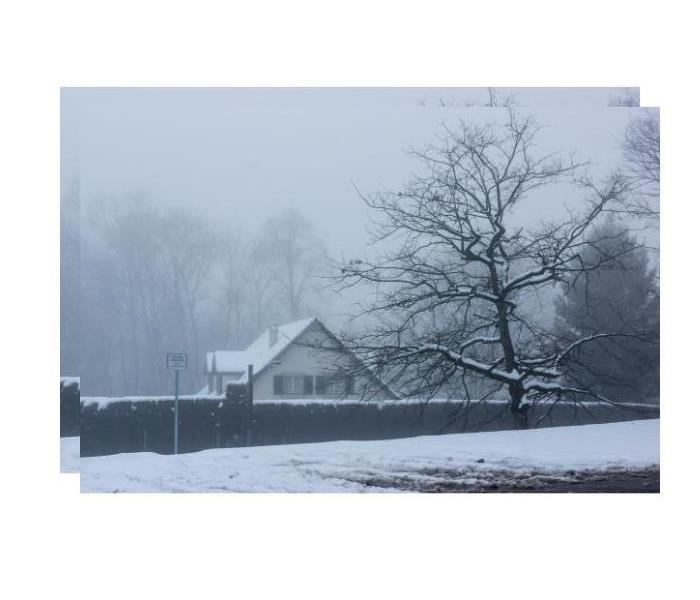 SERVPRO of Springfield is your restoration professional.
SERVPRO of Springfield is your restoration professional.
The winter is upon us and with that comes a myriad of possibly less than ideal weather. SERVPRO of Springfield wants you and your family to be prepared and safe. Preparing for winter weather may not 100% prevent disasters in your home caused by snow, wind, or ice but it will certainly help you and your family get through a winter storm more comfortably.
Making a plan is a great way to get ahead of any weather. You still may need to be among the many many people that flock to the store when a storm is predicted to stock up on bread and milk. Why do we do this, by the way? Is french toast the office “snow day” food? I don’t think I have ever had french toast while I was snowed in but I digress.
Being prepared for a predicted heavy snowstorm will help you and your family to feel more comfortable. Make a plan and be sure your entire family is well aware of your plan for each of them.
Know where to go to stay warm. If you have a certain part of your home you can use to stay warmer in case of loss of power, it’s best to block all drafts, dress in layers, alternate heating sources available.
Stock emergency supplies. It’s a good idea to have an extra supply of extra batteries, a battery-powered radio, bottled water, non-perishable food, first aid kit, medications, and a well working well-maintained fire extinguisher.
Don’t forget your pets. Please be sure your pets are safe indoors and have access to water and food.
Sign up for emergency alerts through the National Weather System. They are a great resource although we recommend listening to a local radio station that will keep you updated on what is happening in your area.
Protect your home by keeping the gutters cleaned, be sure your home is well insulated, and be aware of any pipes that may be exposed to the elements and need to be covered or warmed.
It’s always a great idea to do some research to find new ways to protect your home from the winter weather. Your home is likely one of your most costly investments so keep it in excellent working order. Our family on the other hand is truly our most precious gift, keeping our family safe by participating in preparing for winter storms is a great way to keep our family healthy and happy.
As always, if disaster strikes, SERVPRO of Springfield is serving Sangamon, Macoupin, Morgan, Cass, and Montgomery counties and is always here for you. We can be reached 24/7 at 217-528-7775.
Winter Storm Products
11/23/2020 (Permalink)
 SERVPRO of Springfield is serving as your local restoration company.
SERVPRO of Springfield is serving as your local restoration company.
Not to rush our beautiful fall weather, it’s truly my favorite time of year. The only downside is it is quickly followed by winter weather. Winter weather isn’t all bad, it’s nice if we can be prepared and ready for anything old man winter may throw our way. Let's start with some terminology, the National Weather Service has a great website and is an amazing resource. Winter Storm Products - We have all heard words like “warning”, “watch”, and “advisory”. We hear these things from our meteorologist, on the radio, and even from the sweet lady at our grocery store check out lane. We all chat about the weather but what do these things actually mean? What should we do with this information? The National Weather Service has given us a list with some definitions:
Winter Storm WARNING: Snow, sleet, or ice are expected. Take Action!
Winter Storm WATCH: Snow, Sleet, or ice is possible. Be Prepared.
Winter Weather Advisory" Wintery weather is expected. Exercise Caution.
Freezing Rain: Rain that freezes when it hits the ground; creating a coating of ice on road, walkways, trees, and powerlines.
Sleet: Rain that turns into ice pellets before reaching the ground. Sleet also causes moisture on the road to freeze and become slippery.
The National Weather Service is a great resource to find how to prepare for many types of weather-related storms. When disaster does strike, please know, SERVPRO of Springfield is Here to help. We are serving the Sangamon, Macoupin, Morgan, Cass, and Montgomery counties in your time of need. Please call the experts in disaster relief, you can reach us 24 hours a day, 365 days a year. We know mother nature does not take a day off so we don’t either. You can reach us anytime at 217-528-7775.
Resource: www.weather.gov/safety/winter-ww.
Winter Checklist
9/28/2020 (Permalink)
 SERVPRO of Springfield is your local water and fire restoration expert.
SERVPRO of Springfield is your local water and fire restoration expert.
Autumn is such a wonderful time of year. Many times, here in the Springfield IL area, we get to enjoy a variety of temperatures. It is often quite chilly in the morning and evening while still getting into the 70s and sometimes 80s during the daylight hours. This may create a little more laundry for us but it’s so nice to be able to get some much needed fun in the sun before it’s gone for a few months. Just don’t forget to make sure your home is ready for those upcoming winter months. October is the perfect time to mark off some of those to-do list items. I have compiled a list to help you in preparing your home for those cold cold winters.
Weatherproof your home.
Weatherproofing your home could potentially save you a lot of stress and money down the road. This type of maintenance is incredibly important to keep your home in good condition and keep you aware of issues that may not necessarily need immediate attention but will, in the future.
- Insulate any water lines that run along exterior walls so your water supply will be less likely to freeze.
- Caulk and weather-strip doors and windows.
- Insulate walls and attic.
- Install storm or thermal-pane windows or cover windows with plastic from the inside.
- Repair roof leaks and cut away tree branches that could fall on your home or other structure during a storm.
Autumn is the perfect time to give our homes a little extra TLC and take inventory on jobs that need to be fixed immediately and jobs that can wait until Spring or Summer.
As always, if disaster strikes, SERVPRO of Springfield is serving Sangamon, Macoupin, Morgan, Cass, and Montgomery counties and is always here for you. We can be reached 24/7 at 217-528-7775.
Central Illinois Storm Damage
9/24/2020 (Permalink)
Central Illinois can have some nasty weather and sometimes a complete change in temperature in just a few hours or even minutes. We learn quickly to layer our clothing during certain times of the year. It will be cold, requiring a jacket in the morning and by 1:00 pm we are peeling off those outer layers. This is easy to adjust to, it’s the rainstorms, tornadoes, and wind that make us all a little nervous. They pop up sometimes with little warning.
These storms can wreak havoc on our homes and outdoor structures. Many of us have a plan to protect ourselves and our family but unfortunately, we cannot put our entire homes in a bubble when there are strong winds coming. Recently my own home was very affected but straight-line winds, taking out 4 very large trees. Fortunately for us, those trees did not hit our home or cause any damage other than a mess. It made me think, if those trees were planted even six feet closer to our home, we would have had some major issues. We may not be able to protect our home for these types of storms but we can have a “just in case” plan.
Make sure your homeowner's insurance is covering you for those types of losses. Have a review with your insurance agent and make sure he/she is aware of all the large trees and all other structures on your property and they are covered properly as well as contents. Ask your agent to keep photos on file of your home, all other structures, and any valuable contents such as jewelry, computers, guns, antiques, and anything else that may be out of the normal contents. Review your deductibles as well as when that deductible applies. Many insurance companies are switching to a percentage deductible vs a flat fee deductible. It is better to be aware of these things ahead of time rather than learning something new about your coverage when you already have so much to deal with when handling storm damage to your home.
Be sure to contact SERVPRO of Springfield for all your restoration needs. If you have insurance, we work with that company. Once our CSR has come to your home and reviewed the damage, we work directly with the insurance adjuster, sending them sketches of the damage and detailed reports on what contents and flooring need to be worked on. We are your full-service restoration company. Our goal is to make you happy and less stressed. Depending on the extent of damage, we may restore your belongings in your home or we may bring them back to our shop. If you have structural damage, we will be in communication with the contractor to be kept informed and start on your home as soon as we can. We want you back in your home and back to normal as quickly as possible.
SERVPRO of Springfield is your local restoration company serving Sangamon, Macoupin, Morgan, Cass, and Montgomery counties, we are Here to Help! Please call us at 217-528-7775 any time of day 24/7 and 365 days a year, we are always open and ready to serve you in your time of need.
Tornado Safety Tips
8/22/2020 (Permalink)
If you live in the midwest, you have most likely experienced a tornado in your general area. If you have not, consider yourself lucky. Here in central Illinois, we have had some major damage done to some of our cities that take months or years to recover. The last tornado in our area that caused extensive damage was in Taylorville in 2018. We are incredibly thankful we did not have any major injuries or deaths but we did experience some major structural damage to many homes, personal property, and businesses. SERVPRO was proud to be a leader in restoration during that time of need. Tornadoes are difficult to prepare for because many times we don’t have a lot of notice. What we can do is be prepared as possible ahead of time. We have put together some potentially life saving tips for you and your family to read over and take action.
- Have a Plan. If you have a basement, please use it. If you do not have a basement or lower level, go to an interior room with no windows or outside doors. Using a mattress to cover your head and body from debris is recommended, if you do not have a mattress, use a blanket, if that is not available, use your arms to protect your head from possible flying debris. It’s also recommended to have an emergency kit with enough supplies to provide for your family for 72 hours.
- Practice your Plan. Having a plan at home is great but if no one in your family is aware, it’s useless. Be sure to practice your plan using different times of day and while your family is in different areas of the home. Be sure they are aware of the safest areas of your home and the least safest. Explain to small children why it’s so important to be away from windows and doors and the importance of being face down and covering their heads because of flying debris.
- Talk with your children about their plan at school as well. Again, reiterate the importance of positioning. Communication and practice will help your child to feel more secure and confident in a time of crisis.
- Do not bother with your windows. It’s been said to raise windows in order to equalize pressure in your home during a tornado. This is a myth. The fact is if there is a tornado over your home, it’s likely the windows will be blown out anyway so let’s make sure you are nowhere near them. Please do not bother with the windows at all and go straight to your safe room and take cover.
- Know the sounds and alerts. Make yourself and your family aware of what the tornado siren sounds like in your community. Watch your local news or listen to your local radio. They will likely be keeping you updated on locations and recommending actions to keep you and your family safe.
I have copied the definitions for both tornado warning and tornado watch directly from the National Weather Service website; weather.gov
- Tornado Watch: Be Prepared! Tornadoes are possible in and near the watch area. Review and discuss your emergency plans and check supplies and your safe room. Be ready to act quickly if a warning is issued or you suspect a tornado is approaching. Acting early helps to save lives! Watches are issued by the storm prediction center for counties where tornadoes may occur. The watch area is typically large, covering numerous counties or even states.
- Tornado Warning: Take Action! A tornado has been sighted or indicated by weather radar. There is imminent danger to life and property. Move to an interior room on the lowest floor of a sturdy building. Avoid windows. If in a mobile home, a vehicle, or outdoors, move to the closest substantial shelter and protect yourself from flying debris. Warnings are issued by your local forecast office. Warnings typically encompass a much smaller area (around the size of a city or small county) that may be impacted by a tornado identified by a forecaster on radar or by a trained spotter/law enforcement who is watching the storm.
- If you are driving and can find a shelter inside a building, that is best. If there are absolutely no buildings in your area to seek shelter, you should look for the lowest possible land and lie on your stomach covering your head with your arms. If there is no low lying land, your last option would be to remain in your car with your seat belt on crouching as low as your can under the windows covering your head. Using a blanket or any material to cover your face and head to protect yourself from flying debris. Do not shelter under a bridge or overpass.
SERVPRO of Springfield, we are your restoration experts. We are Here to Help you and your family through any disaster.
As always, if disaster strikes, SERVPRO of Springfield, Morgan, Cass, and Montgomery counties is always here for you. We can be reached 24/7 at 217-528-7775.
Downed Power Lines, Do's & Don'ts
6/15/2020 (Permalink)
In central Illinois, we have storms of all kinds from rain with thunder & lightning, hail, to wind, and everything in between. These can all cause damage in their own right to cars, homes, and anything in their path. Power lines can be particularly vulnerable in the path of a tornado, high winds, or lightning strikes. When power lines are knocked down or loose, this can be extremely dangerous. We have done some research for you to guide you in some do’s and don’ts if you see downed power lines in your path.
DOs
GO AHEAD AND ASSUME. Downed power lines can be deadly. Please go ahead and assume that all downed lines are energized and avoid all contact with them.
KEEP A SAFE DISTANCE. Keeping a MINIMUM of a 30 foot distance (about 3 car lengths) from the downed lines is the first step to staying safe.
SHUFFLE. While moving away from the power lines, you should keep both feet on the ground while moving away from them. Shuffle your feet against the ground without losing contact with the ground and gaining distance between yourself and the downed power lines.
REPORT. Report the lines immediately once you are at a safe distance.
CALL 911. If you see someone injured from a downed power line.
DON’Ts
HANDS TO YOURSELF. Refrain from touching any downed power line. You should assume all downed lines are active and energized. Refrain from touching any other object that is in contact with the downed power line such as guardrails, fences, and cars.
NO POKING. Although you may have learned in science class which materials are conductive, however, do not use even these types of materials to move or relocate a downed power line.
NO RUNNING. When moving away from downed power lines, do not allow your feet to lose contact with the ground, instead, shuffle your feet against the ground until you are a safe distance from the downed power lines.
DON’T BECOME A VICTIM. Do not try to rescue an individual that has been injured from touching a power line. The electrical current can travel through them to you and you risk becoming a victim yourself.
As always, if disaster strikes, SERVPRO of Springfield, Sangamon, Morgan, Cass, and Montgomery counties is always here for you. We can be reached 24/7 at 217-528-7775.
When Lightning Strikes
5/22/2020 (Permalink)
Lightning Facts
We have put together a few facts about lightning that might shock you. Lightning can be beautiful and humbling. Watching those huge bolts light up a night sky leaves us in awe of its beauty and also how incredibly dangerous it can be. It can be extremely costly both economically and personally. Lightning losses to the United States economy approaches $7 billion per year and kills an average of 47 people per year.
- A lightning strike is hotter than the surface of the sun and can reach temperatures around 50,000 degrees
- A single bolt of lightning hits the ground somewhere in the world about 100 times every second.
- That’s 8 million lightning strikes per day
Lightning Damage
It is estimated that almost one-third of all US businesses will suffer lightning damage at some point. The insurance industry experiences an average of $15 billion in losses annually due to lightning damage.
- 30% of power failures due to lightning, annual cost over $1 billion
- 5% of insurance claims involve lightning
- Commercial and Military Aircraft costs - $4 billion
- Lightning causes damage to perhaps 200,00 computers and networks every year
Lightning Protection
Lightning is a giant spark of electricity in the atmosphere or between the atmosphere and the ground. In the initial stages of development, air acts as an insulator between the positive and negative charges in the cloud and between the cloud and the ground; however, when the differences in charges become too great, this insulating capacity of the air breaks down and there is a rapid discharge of electricity that we know as lightning.
A lightning protection unit provides a specified path or redirection of the lightning potential to less volatile locations.
Lightning can be extremely dangerous and very destructive. We want you to be safe and sound. It’s difficult to defend against something so erratic and destructive but we can do our best by knowing what is possible and doing some research on different types of surge protectors and rods.
As always, if disaster strikes, SERVPRO of Springfield, Sangamon, Morgan, Cass, and Montgomery counties is always here for you. We can be reached 24/7 at 217-528-7775.
Tornado Warning vs Watch
4/27/2020 (Permalink)
We have a lot to watch out for, weather-wise, and knowing the difference in the terminology used by the National Weather Service can save lives. Tornadoes are common in our area so it’s important to know the difference between a warning and a watch.
If you are in an area where there is a Tornado Watch, this is the time to be prepared. This indicates tornadoes are possible in and near the watch area. You should review and discuss your emergency plans and check supplies. Having a plan and knowing where the safest place is in your area is important. Be ready to act quickly if a warning is issued by the Storm Prediction Center for counties where tornadoes may occur. The watch area is typically large, covering numerous counties or even states.
If your area has a Tornado Warning, take action immediately. The tornado warning indicates a tornado has been sighted or indicated by weather radar. There is imminent danger to life and property. Move to an interior room on the lowest floor of a sturdy building. Avoid all windows. If you are in a mobile home, a vehicle, or outdoors, move to the closest substantial shelter and protect yourself from flying debris. Warnings are issued by your local forecast office. Warnings typically encompass a much smaller area, around the size of a city or small county that may be impacted by a tornado identified by a forecaster on Radar or by a trained spotter or law enforcement who is watching the storm.
As always, if disaster strikes, SERVPRO of Springfield, Sangamon, Morgan, Cass, and Montgomery counties is always here for you. We can be reached 24/7 at 217-528-7775.
Flash Flood
3/23/2020 (Permalink)
Spring is coming and I will speak for myself when I shout, “Hallelujah!” I’m ready to be outside in the warm sunshine planting flowers and my vegetable garden. These are my first thoughts when you mention spring, however, we all know that rain, rain, and more rain is also associated with spring here in central Illinois. Being prepared for rain can be quite difficult. Even with all of our technology, it's still very difficult to predict exactly how much precipitation we will get and even more importantly, how quickly we will get it. When we experience a large amount of rain in a short amount of time, this could cause a flash flood.
Flash floods can be extremely dangerous. A flash flood is a rapid flooding of low-lying areas: washes, rivers, dry lakes, and depressions. It may be caused by heavy rain associated with a severe thunderstorm, hurricane, tropical storm, or meltwater from ice or snow flowing over ice sheets or snowfields.
We need to be ever vigilant in large amounts of rain in a short amount of time. It’s very dangerous to walk around or drive in flash flood conditions. Water moving at 9 feet per second (2.7 meters per second), a common speed for flash floods, can move rocks weighing almost a hundred pounds. Flash floods carry debris that elevates their potential to damage structures and injure people. If you find yourself in the middle of a flash flood, stay inside if at all possible. If you are outdoors and cannot get inside, go to high ground. Try to stay out of the way of debris. Flash floods are extremely dangerous but fortunately, they don’t last too long. If you find a safe place, stay there until you know it’s safe to move.
As always, if disaster strikes, SERVPRO of Springfield, Sangamon, Morgan, Cass, and Montgomery counties is always here for you. We can be reached 24/7 at 217-528-7775.
SERVPRO of Springfield at Your Service
1/23/2020 (Permalink)
We talk about prevention a lot. Of course, we all try to be diligent in preventing any damage to our homes but sometimes mother nature does not give us a choice. We might do all of the things on the checklist to prevent water pipes from freezing but it may happen anyway. A burst pipe is a common occurrence, as roughly fifty-million homeowners experience a burst pipe every year. One of the major issues that burst pipes bring is that a ? inch crack can easily lead to over 250 gallons of water flooding your home daily if left untreated. However, with each flood situation being different, each requires a unique solution. If this is the case and you do experience a burst pipe in your home, I have provided a few guidelines to follow to help reduce any further damage.
Turn off Your Main Water Supply - This is the first and important step for avoiding further water damage to your home. Shutting down your main water supply stops all water throughout the home and makes it easier to repair the burst pipe. In some cases, you may have to turn off your main power switch of the leak is happening near an electrical source.
Turn Off Valves - If the burst pipe routes from a hot water tank, close off the hot water valve to avoid loss of water and possible injury.
If the Pipe is Frozen - If the pipe happens to be frozen, don’t let it thaw.
Call SERVPRO - Once the water is shut off from the home, call SERVPRO of Springfield immediately. This avoids further damage to your home and property. Our experts are on call 24/7 365. We will be on-site to start the drying process, this prevents further damage such as mold and mildew. Our experts will clean and dry personal property as well as walls and flooring. There is no job too big or too small.
Take Inventory - Take inventory of the damaged property from the burst pipe. Once this is accumulated, contact your insurance provider.
As always, if disaster strikes, SERVPRO of Springfield, Sangamon, Morgan, Cass, and Montgomery counties is always here for you. We can be reached 24/7 at 217-528-7775.
Preventing Ice Dams
1/4/2020 (Permalink)
Ice Dams can cause a lot of damage to your home so we would like to share some tips that may save you some damage to your home. There are three keys to preventing ice damming; insulate, ventilate, and seal air leaks. Ice damming is caused by the warm air escaping your roof, melting the snow and then it refreezing. When this happens over and over it can cause water to seep into your roof and cause damage to the inside and outside of your home.
- Make sure your attic is well insulated
- Close up attic leaks
- Add roof & soffit vents for proper ventilation
- Check insulation around sensitive areas such as skylights & dormers, wall edges as well as new additions
- Add a special adhesive ice and water barrier the next time you re-roof your home.
- If conditions are safe, rake the snow off your roof after large snowfalls that have a lot of accumulation.
- Cleaning your gutters in the fall is a great way to maintain your home, not only for Ice Dams but also for maintaining your home as well.
Please know that SERVPRO of Springfield is here for you in the unfortunate event you find water damage in your home caused by an ice dam. Our experts here at SERVPRO of Springfield are trained to dry and clean any spaces that may be affected. As always, if disaster strikes, SERVPRO of Springfield, Sangamon, Morgan, Cass, and Montgomery Counties is always here for you. We can be reached 24/7 at 217-528-7775.
Preventing Frozen Pipes
12/9/2019 (Permalink)
Preventing Frozen Pipes will Prevent Winter Woes.
Sometimes frozen pipes are unavoidable. If you find yourself in a mess from a frozen pipe bursting, SERVPRO of Springfield are your experts in water restoration, from flooring to drywall as well as your personal belongings.
When we talk about frozen pipes, this actually refers to water inside the pipe freezing. This can cause expansion within the pipe which in turn causes the pipe itself to burst.
Draining all outside faucets in a great start to helping to prevent frozen pipes.
Wrapping pipes with heat tape that may be exposed to the elements or that do not have heat access is a great way to help prevent water from freezing inside the pipe.
Insulate and caulk around pipe openings.
Opening cabinet doors to pipes in your kitchen and bathrooms can expose enough heat to the pipes that this can help prevent water from freezing down the pipeline.
Leaving your heat at a minimum of 55 degrees, even when you are not home, can help prevent freezing water in your pipes as well.
These are mostly small tips to use to help prevent what could be a major disaster. If you do find yourself in a predicament, SERVPRO of Springfield, Sangamon, Morgan, Cass, and Montgomery Counties is always here for you. We can be reached 24/7 at 217-528-7775.
Snow Storm Prep
12/3/2019 (Permalink)
SERVPRO of Springfield is all about cleaning and restoring, our first priority is the safety of our customers! Whether you've got a few weeks before winter hits or the weatherman just said a major blizzard is already on its way, you'll want to hit a few spots outside and inside the house to be truly prepped for the storm. This will protect not only your home itself from costly damages but make life easier on you too!
Turn off outside faucets
Pipes leading to outdoor faucets and hoses are particularly vulnerable to damage when the temperature plummets, so it's crucial that you make turning them all off part of prepping for a snowstorm, even if you have little time to spare. So be sure to shut off the inside valves leading out to them, unhook hoses, and run your outdoor faucets to drain any water that might be hiding within.
Warm-up your indoor pipes, too
To prevent burst pipes indoors, keep cabinet doors under sinks open so warm air in your home can reach them more easily. This is primarily important if temperatures get so low that your furnace has a hard time keeping up.
Clear your gutters
Make sure your rain gutters are clear of leaves. Ice dams can form during winter storms, and if the gutters aren’t clean, they can flood the home at the worst time.
Keep vents clear of snow
Indoor heating systems can shut down when the outside vents get blocked with snow. It’s important to keep these vents clear using a shovel or broom.
We wish you a Happy Winter and hope you stay safe! As always, if disaster strikes, SERVPRO of Springfield, Sangamon, Morgan, Cass, and Montgomery Counties is always here for you. We can be reached 24/7 at 217-528-7775.
Do You Know the Winter Weather Terms?
12/2/2019 (Permalink)
Winter Weather Advisory: Expect winter weather conditions that could cause severe inconvenience and life-threatening hazards.
Frost/Freeze Warning: Expect below-freezing temperatures.
Winter Storm Watch: Be alert; a storm is likely.
Winter Storm Warning: Take action, the storm is in or entering the area.
Blizzard Warning: Seek refuge immediately! Snow and strong winds, near-zero visibility, deep snow drifts, and life-threatening wind chill.
For winter storm damage, SERVPRO of Springfield and Sangamon, Morgan, Cass, Macoupin, Montgomery Counties is Here to Help! Give us a call 24/7 at 217-528-7775.
10 Things To Do Before The Power Goes Out
11/14/2019 (Permalink)
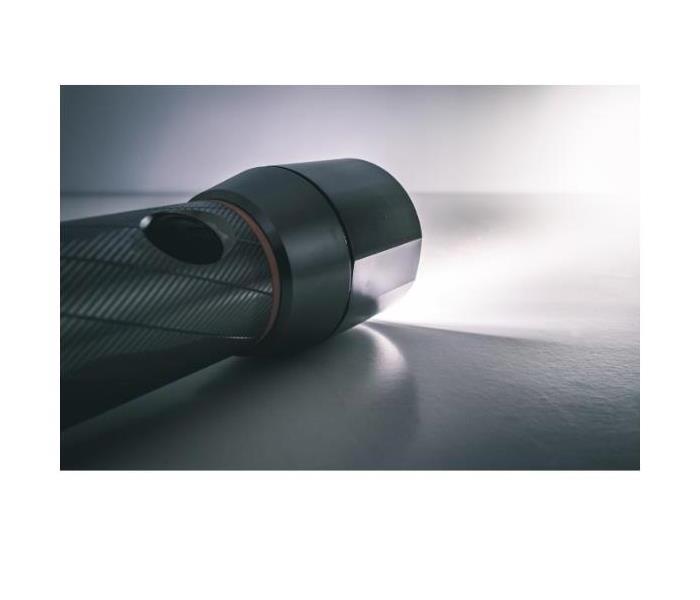 A great tip is to keep flashlights and fresh batteries in a safe and consistent location.
A great tip is to keep flashlights and fresh batteries in a safe and consistent location.
We all listen to the weather and MOST of the time have a pretty good idea when there is a storm brewing that will likely cause some inconveniences in our day to day life. We hope you find some good tips for you and your family on this list to help make time without power a little less scary and a little more relaxing.
- When the Lights go down...
When the lights flicker my first thought is, “where did I put that flashlight?” One of the first thoughts most of us have are either the flashlights or batteries. Be sure to have a constant safe place for your flashlights and fresh batteries.
Heat is going to be very important if the power is out for an extended period of time. There are options such as small propane heaters but these are not safe to use for the long term. The best option would be to use a space heater connected to a generator. If you have natural gas, be sure to have a full tank in case of an extended outage. If all else fails, have plenty of blankets and warm clothing. Layering clothing is a must to keep out the cold.
It’s important to keep your gas tank full as well. If you need to get to a family member, friend, or have an emergency, it’s important to be prepared. It’s possible in the case of a power outage for an extended time frame, gas stations may be closed or out of fuel.
Water is an essential part of our day. Most cities and counties have back systems for power outages but if one should fail, or a pipe freezes in your home, you do not want to be without water. Preparing for a scenario where you cannot get water from a faucet is the best way to be prepared. You can fill your bathtub with water to use in a variety of ways such as flushing the toilet, cleaning up, boiling and using for cooking. It’s a good idea to keep bottled water on hand as well as large containers filled with water.
- Ring the Dinner Bell - Food
Most of us prepare for meals in the short term, one day to a week in advance. It’s vital to keep a variety of non-perishable food in your pantry that doesn’t require a lot of cooking. Foods that you can open and eat are great to have on hand such as granola/protein bars, nuts, jerky, and peanut butter.
These are great to have, however, if you are enduring a long term power outage it will be nice to have some hot food. Stocking up on canned soups, stews, chilis, and veggies is a great idea when you get tired of the “eat and go” convenience foods.
- Dinner is Served - Cooking
If you have a gas stove, you probably won’t be too bothered or inconvenienced. There are some alternatives to the electric stove such as your charcoal or propane grill. Also using a camp stove or propane burner is a quick easy way to warm up those meals in a can. Be sure to use these cooking devices in a safe location.
When you hear of a possible storm, one easy way to keep the lines of communication open with your loved ones is to charge your cell phones and laptops prior to the storm hitting. This hopefully allows you to plan and organize any evacuation plans or plans to bring your loved ones together to ride out the storm together. This also allows you to stay informed as to what is happening outside your home.
Keeping a two week supply of medication can be a lifesaving tip for those who either cannot get out or in an extended power outage, the pharmacy may be closed. This particular tip is fairly easy for most of us to adhere to on a regular basis. Participating in a mail-order prescription plan is a great way to prepare, they are normally mailed in 3-month supplies.
Here at SERVPRO, we are experts in this field. Making sure you have all your housework done, prior to a storm is a great way to conserve water while it may not be as readily available. Making sure your dishes and clothes are washed allows you to concentrate on other priorities that may be more important to you.
Following these few tips in a storm situation can lead you to some much needed downtime with your family and loved ones. Be sure to plan for some “unplugged” fun with board games and books. Make this a time to enjoy your family and be creative to make this experience a great memory for the whole family.
As always, if disaster strikes, SERVPRO of Springfield, Sangamon, Morgan, Cass, and Montgomery Counties is always here for you. We can be reached 24/7 at 217-528-7775.
Winter-Proof Your Home
10/28/2019 (Permalink)
WINTER CHECKLIST FOR YOUR HOME
- Clean leaves and debris out of window wells, gutters and downspouts to keep water from pooling and freezing.
- Install screens on exterior vents and pet doors to keep rodents out. Make sure garage doors close completely, too.
- Clear ground clutter such as sticks and lawn ornaments - tripping hazards come snowfall.
- Trim shrubs and trees to keep branches from breaking and blowing onto the house.
- Turn off water taps and bring in hoses (water inside hoses might freeze and expand, causing damage).
- Ensure stairwell handrails are sturdy and secure. When it gets slippery, you'll want to grip them.
- Clear the chimney of obstructions, such as birds' nests, and any built-up (and flammable) creosote.
- Check the roof for loose or broken shingles or flashing and patch if necessary.
- Remove window screens and install storm windows for better insulation.
- Redo caulking and weatherstripping around doors and windows, and fill any remaining gaps with insulation foam, to seal heat in.
- Check the attic, basement, windows and doors for air leaks. Darkened, dirty spots in insulation, or a candle flame wavering in a draft, may signal a leak.
- Have your furnace checked by a professional. Change the filter if needed (do this every 3 months, or sooner if the filter looks dirty).
- Install carbon monoxide detectors. The risk of carbon monoxide poisoning increases when furnaces are in frequent use and leaks more likely.
- Move flammable materials and electric appliances away from heating devices.
- Reverse ceiling fans to a clockwise spin to push warm air down from the ceiling, for improved heating efficiency.
- Change outdoor lightbulbs and set automatic light timers for earlier hours of darkness.
- Test downspouts to ensure proper drainage from the roof.
As always, if disaster strikes, SERVPRO of Springfield and Sangamon, Morgan, Cass, Montgomery Counties is always here for you. We can be reached 24/7 at 217-528-7775.
LIGHTNING SAFETY
10/25/2019 (Permalink)
Lightning Safety Tips
- Do not use corded phones. Cellular or cordless phones are acceptable.
- Do not touch electrical equipment such as computers, TVs or cords. Remote controls are acceptable.
- Avoid plumbing. Do not wash your hands, take a shower or wash dishes.
- Stay way from windows and doors and stay off porches.
- Do not lie on concrete floors or lean against concrete walls.
- Protect your pets: Dog houses are not safe shelters. Dogs that are chained to trees or on metal runners are particularly vulnerable to lightning strikes.
As always, if disaster strikes, SERVPRO of Springfield and Sangamon, Morgan, Cass, Montgomery Counties is always here for you. We can be reached 24/7 at 217-528-7775.
When Storms Hit, We Are READY!!
9/30/2019 (Permalink)
Storm and flood damage require specialized restoration techniques and equipment. Lucky for you, the staff here at SERVPRO of Springfield and Sangamon, Morgan, Cass, Macoupin, Montgomery Counties have both! Since we are locally owned and operated and open 24/7, we can respond quickly which is key. A faster response can limit damage and save you in the long run. Let us make it "Like it never even happened." Contact us for any of your storm damage needs at 217-528-7775.
Preparing Your Home or Business NOW For Cold Weather
8/28/2019 (Permalink)
Fall will soon be upon us and you know what follows soon after that....WINTER!! Cold weather can have a huge impact on your home or business if you are not ready for it. From heavy rain and freezing temperatures to damaging winds, sleet, or snow.....all can cause serious and costly property damage. While you cannot control the weather, you can take steps to be prepared and help take the sting out of winter weather.
To help prevent costly damages due to weather, consider taking the following precautions to protect your property before cold weather hits:
- Check your property for downed tree limbs and branches. Wind, heavy rain, ice, and snow can cause branches to fall, which could cause damage to the property and potentially cause personal injuries.
- Roofs, water pipes, and gutters should all be inspected to ensure they are in proper order. Gutter downspouts should be directed away from your building. Clear gutters of all debris. Leaves and other obstructions can cause a damming effect, which can lead to roof damage and interior water problems.
- Inspect property, especially walkways and parking lots, for proper drainage to alleviate flood hazard potential.
SERVPRO of Springfield is Here to Help! We are available 24/7 and can be reached at 217-528-7775
Thunderstorms & Lightning
8/20/2019 (Permalink)
Lightning is a leading cause of injury and death from weather-related hazards. Although most lightning victims survive, people struck by lightning often report a variety of long-term, debilitating symptoms. Thunderstorms are dangerous storms that include lightning and can:
IF YOU ARE UNDER A THUNDERSTORM WARNING, FIND SAFE SHELTER RIGHT AWAY
When thunder roars, go indoors!
Move from outdoors into a building or car.
Pay attention to alerts and warnings.
Unplug appliances.
Do not use landline phones.
HOW TO STAY SAFE WHEN A THUNDERSTORM THREATENS
Prepare NOW
Know your area’s risk for thunderstorms. In most places, they can occur year-round and at any hour.
Sign up for your community’s warning system. The Emergency Alert System (EAS) and National Oceanic and Atmospheric Administration (NOAA) Weather Radio also provide emergency alerts.
Identify nearby, sturdy buildings close to where you live, work, study, and play.
Cut down or trim trees that may be in danger of falling on your home.
Consider buying surge protectors, lightning rods, or a lightning protection system to protect your home, appliances, and electronic devices.
Survive DURING
- When thunder roars, go indoors. A sturdy building is the safest place to be during a thunderstorm.
- Pay attention to weather reports and warnings of thunderstorms. Be ready to change plans, if necessary, to be near shelter.
- When you receive a thunderstorm warning or hear thunder, go inside immediately.
- If indoors, avoid running water or using landline phones. Electricity can travel through plumbing and phone lines.
- Protect your property. Unplug appliances and other electric devices. Secure outside furniture.
- If boating or swimming, get to land and find a sturdy, grounded shelter or vehicle immediately.
- If necessary, take shelter in a car with a metal top and sides. Do not touch anything metal.
- Avoid flooded roadways. Turn Around. Don’t Drown! Just six inches of fast-moving water can knock you down, and one foot of moving water can sweep your vehicle away.
Be Safe AFTER
- Listen to authorities and weather forecasts for information on whether it is safe to go outside and instructions regarding potential flash flooding.
- Watch for fallen power lines and trees. Report them immediately.
Source: www.ready.gov
Remember, if disaster strikes contact SERVPRO of Springfield and Sangamon, Morgan, Cass, Macoupin, Montgomery Counties 24/7 at 217-528-7775.
Preventing Ice Dams on Homes
1/23/2019 (Permalink)
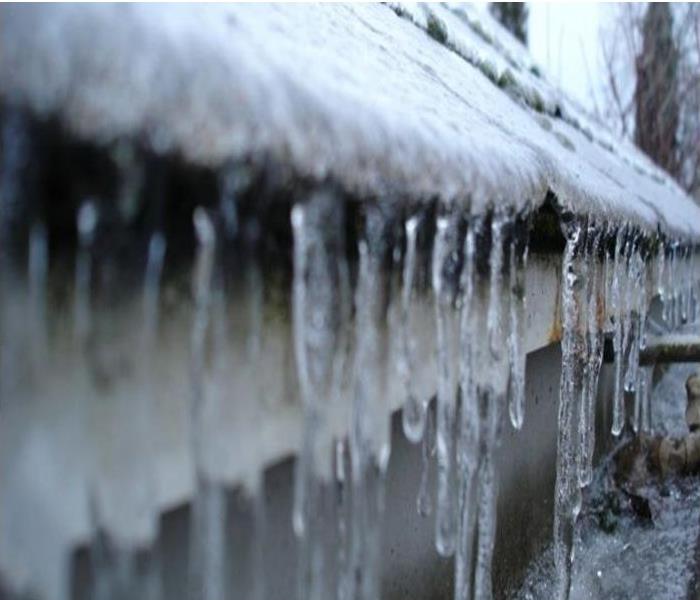 Learn how to reduce your risk of ice dams.
Learn how to reduce your risk of ice dams.
During freezing weather, heat from your home or business can escape through your roof and melt snow on your roof. The snowmelt can then trickle down to the roof’s edge and refreeze, creating an ice dam that leaves additional snowmelt with no place to go but possibly under your roof. The following IBHS guidance will reduce your risk of ice dams.
- Keep all drains, scuppers, gutters, and downspouts free of debris and vegetation that may restrict proper flow.
- Remove or relocate heat sources that are installed in open attic areas directly under the roof, such as an attic.
- Insulate light fixtures in the ceiling below an unheated attic space.
- If you have penetrations into the attic, such as vents, seal and insulate them so that daylight cannot be seen and airflow is minimal.
- If ice dams form around the drains, connect heating cables to the drains to prevent ice buildup. Heating cables can also be placed on the roof, connecting them to the drainage system so a path is created for the melting ice to follow.
Source: disastersafety.org
Staying Safe in A Tornado
12/30/2018 (Permalink)
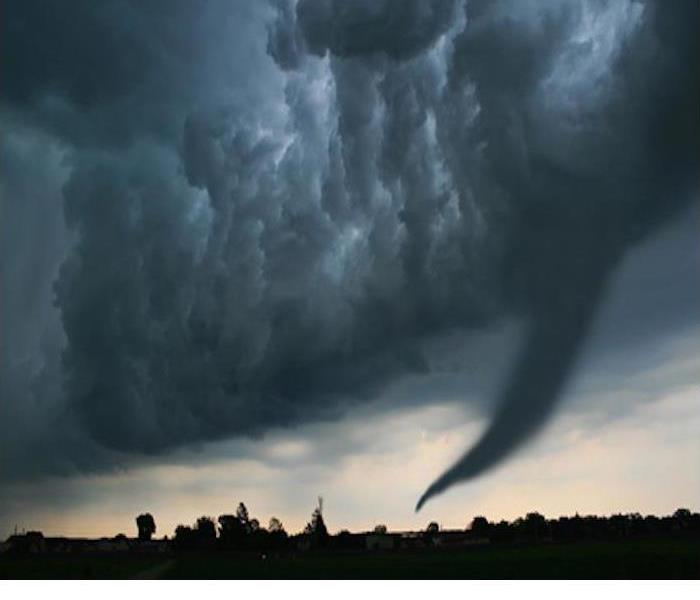 Do you have a weather plan and emergency kit prepared?
Do you have a weather plan and emergency kit prepared?
To stay safe during a tornado, prepare a plan and an emergency kit, stay aware of weather conditions during thunderstorms, know the best places to shelter both indoors and outdoors, and always protect your head.
Tornadoes continue to impact locations across the country every year, bringing massive winds and destruction in their paths.
The 2016 tornado season claimed the lives of 18 individuals and injured another 325. Seventy-eight percent of those victims were in a mobile home or trailer park at the time of the tornado. These storms caused an estimated $183 million in property damage.
According to the National Oceanic and Atmospheric Agency (NOAA)there is no guaranteed safety during a tornado. Even the possibility of a tornado must be taken seriously. Although the most violent tornadoes can level and blow away almost any house and those within it, extremely violent EF5 tornadoes are very rare. Most tornadoes are much weaker. You can survive a tornado if you follow safety precautions. Here are three important tips to help keep you safe.
TIP 1: Be prepared.
The best way to stay safe during a tornado is to be prepared with:
- fresh batteries and a battery-operated TV, radio, or internet-enabled device to listen to the latest emergency weather information;
- a tornado emergency plan including access to a “safe shelter” for yourself and for people with special needs;
- an emergency kit (including water, non-perishable food, and medication); and
- a list of important information, including telephone numbers.
Make sure your children know what a tornado is, what tornado watches and warnings are, what county or parish they live in (warnings are issued by county or parish), and what constitutes a location as a “safe shelter,” whether at home or at school.
TIP 2: Stay aware of weather conditions.
To protect yourself and your family from harm during a tornado, pay close attention to changing weather conditions in your area. If you know thunderstorms are expected, stay tuned to local radio and TV stations or an NOAA weather radio for further weather information. Some tornadoes strike rapidly without time for a tornado warning. The following weather signs may mean that a tornado is approaching:
- a dark or green-colored sky;
- a large, dark, low-lying cloud;
- large hail; or
- a loud roar that sounds like a freight train.
If you notice any of these conditions, take cover immediately, and keep tuned to local radio and TV stations or to a NOAA weather radio or check the internet.
TIP 3: Know where to shelter.
Falling and flying debris cause most deaths and injuries during a tornado. Although there is no completely safe place during a tornado, some locations are much safer than others.
- Go to the basement or an inside room without windows on the lowest floor (bathroom, closet, center hallway).
- Avoid windows.
- For added protection get under something sturdy (a heavy table or workbench). Cover your body with a blanket, sleeping bag or mattress. Protect your head with anything available.
- Do not stay in a mobile home.
If you are outside or in a mobile home, find a nearby building preferably with a basement. If you are in a car, do not try to outrun a tornado but instead find the nearest sturdy building. NOTE: You may need to change your plans and change locations when the tornado watch is issued.
No one can know a tornado’s strength before it touches down, so keep up with local weather information, especially when thunderstorms are forecast. Prepare your home and family for the possibility of a tornado. Moving to shelter quickly is easier when everyone knows where to go, whether in your home or outdoors. Following these tips will give you the best chance for staying safe in a tornado.
Tips to Winterize Your Home
12/1/2018 (Permalink)
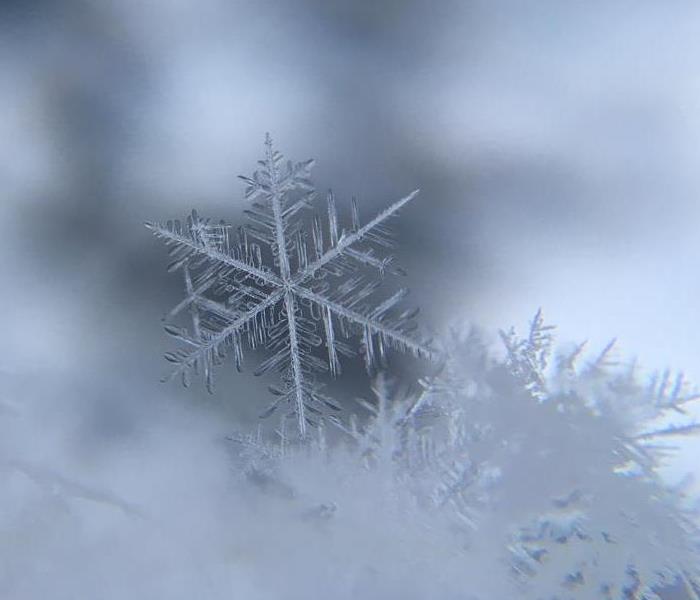 Are you prepared for when the snow starts falling?
Are you prepared for when the snow starts falling?
Winter storms can range from a brief period of extreme cold temperatures, to days of snow, blowing wind and white-out conditions. Preparing in advance helps you tackle winter weather before it even begins. Run through these tips to make sure you stay cozy during this winter season.
- Seal exterior doors with weatherstripping if you feel any cold air leaks. You can use a candle to detect even the smallest of leaks.
- Door sweeps are an excellent way to stop drafts from entering the home from exterior doors.
- Seal leaks in the attic paying close attention to electrical outlets, fixtures and pipes. Also check wiring that comes into the home from outside.
- It is also a good idea to go ahead and add some insulation to the attic that will not only help keep the home warm during the winter but will help keep it cooler in the summer.
- Close the damper on your chimney when the fireplace is not in use.
- Heating ducts can leak a lot of the much needed warm air so be sure to make sure they are sealed properly. Duct cleaning is beneficial as well and is one of the many services provided at SERVPRO of Springfield.
- Servicing your furnace regularly will help prevent major breakdowns in the future.
- Replace the filters in your furnace monthly to optimize air flow.
- Insulate the pipes in the basement or crawlspace to prevent frozen pipes.
- Window coverings are a great way to conserve heat in the home.
For more information on winterizing your home, visit https://www.moneytalksnews.com/16-low-cost-ways-prepare-your-home-for-winter/
If you would like any information on Duct Cleaning please give us a call at (217) 528-7775.
Flooding Can Lead to Mold
10/23/2018 (Permalink)
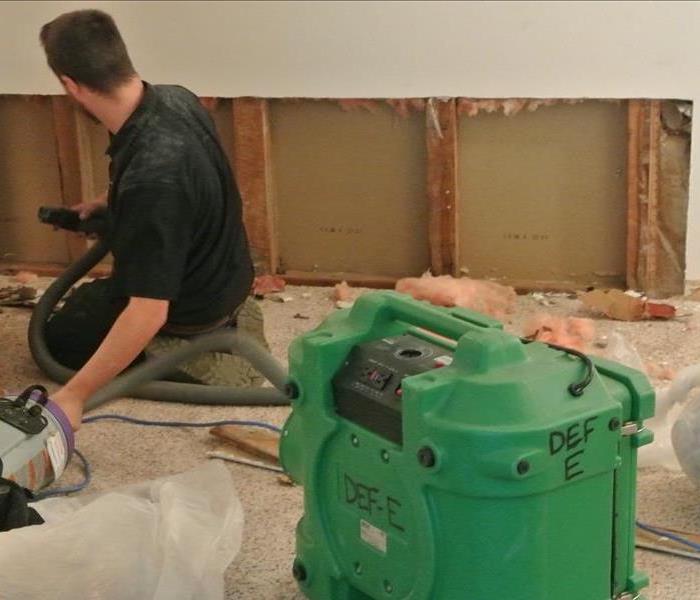 It is important to get professional assistance with cleaning up after a flood event!
It is important to get professional assistance with cleaning up after a flood event!
Flood damaged homes are very likely to experience mold damage as moisture permeates the structure of the building for an extended period of time. Mold organisms are found almost everywhere and damp environments allows it to grow and spread through affected areas such as basements, walls, carpet and wood. If you have a flood damaged home, keep an eye out for discoloration on surfaces and the tell-tale musty odor.
If you notice mold in your home, there are things you can do.
- Get the moisture under control. After a flood, the water must be extracted and the structure dried.
- All porous materials (drywall, carpeting, and ceiling tiles) with mold growth should be discarded.
- Appliances that contain insulation should be discarded as they may harbor mold spores that cannot be seen.
- Heating and air conditioning filters need to be changed. The system will need to be inspected by a professional and may need to be replaced.
- Non-porous materials and surfaces will need to be professionally cleaned depending on the extent of the damage. Remember, if clean up is not handled appropriately, it is likely that the spores will spread.
If you experience a water damage and would like to avoid mold call in local assistance, contact SERVPRO of Springfield at 217-528-7775. We are available to help 24/7.
SERVPRO® of Springfield Can Help With Storm Damage Cleanup
9/12/2018 (Permalink)
 Stay safe around storm damage!
Stay safe around storm damage!
SERVPRO® of Springfield knows that in Illinois, your home or business can be affected by a variety different storm damages within a single season. From hail to wind, tornado to snowstorm, we get a little bit of everything around here. Knowing what to look for after a storm is crucial for detecting and restoring issues. Below are areas to check for storm damage:
- Roof: Look for shingles that have discoloration, tearing, or even holes in them. These can all be signs that your roof has been damaged. Another sign is if there are leaks in your roof or your ceiling.
- Gutters: After a hail storm, looking for dents or dings can also give you a better picture of what the storm did to the rest of your home. Your gutters can also give you insight to whether you have roof damage. Check to see if there are granules from the asphalt shingles in your gutter.
- Windows: Look at each of the windows at your homes and note any signs of shattered or broken windows and frame damage. This is especially important after a hail storm or a strong wind storm.
- Exterior: Not only is it important to look at the siding of your home to check for damage, it is also important that you check any appliances.
After your inspection, if you notice any signs of storm damage follow up by checking the area for signs of mold or mildew. If damage has occurred call a local professional to resolve the issue. SERVPRO® of Springfield is always here to help at 217-528-7775.
Heavy Rain Can Cause A Lot of Damage!
8/21/2018 (Permalink)
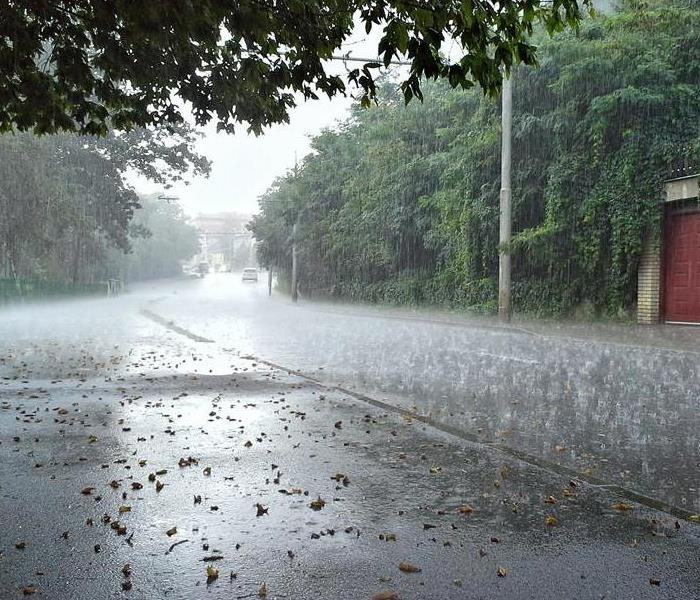 Heavy rains has the potential to cause a variety of problems.
Heavy rains has the potential to cause a variety of problems.
SERVPRO® of Springfield would like to remind everyone about the hazardous potential of heavy rains. Heavy rains can cause unique challenges as a significant amount of rain can fall in a short amount of time. Flooding can occur quickly as the ground is unable to absorb all of the water that is falling. Not only is there an elevated safety risk there is also a potential for home disaster. As a result of heavy rains basements can flood, crawl spaces can take in water, sump pumps can fail and roofs can leak. If you have water come into your home as a result of heavy rains make sure that you call in a professional to get your home back to “Like it never even happened.” We at SERVPRO® of Springfield have been serving the local community for over 30 years. If you experience a loss due to storm damage, give us a call at 217-528-7775.
We Can Help With Storm Damage!
8/8/2018 (Permalink)
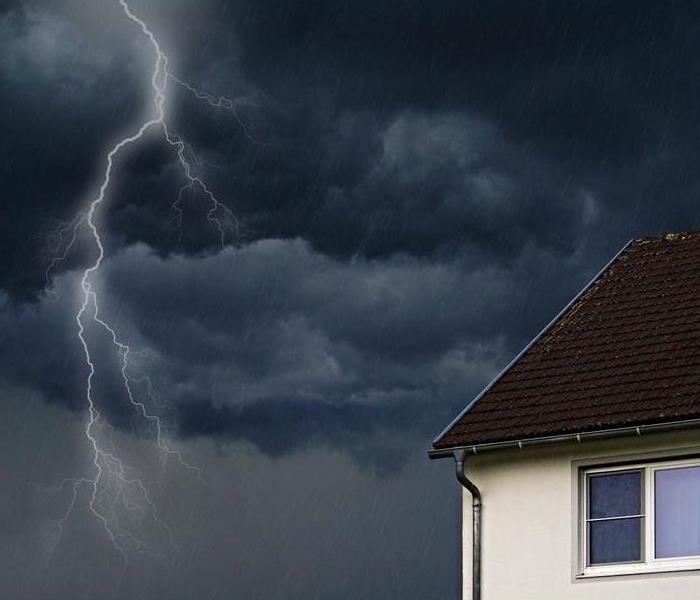 Damage happens. We are Here to Help®.
Damage happens. We are Here to Help®.
SERVPRO® of Springfield knows that a storm is not to be underestimated. Here in the midwest we deal with our fair share of all types of weather and wind, water and lightning can cause damage both seen and unseen. Flooding, downed tree limbs and power lines, fire and broken windows are just a few of the dangers of a storm. We have been helping local residents and business owners in the Springfield area for over 30 years navigate the cleanup process and we look forward to helping others for many years to come.
When disaster strikes your home or business, know that we are here to make it “Like it never even happened.” Call SERVPRO® of Springfield at 217-528-7775. We are available 24/7, 365 days a year.
Summer Storms with SERVPRO® of Springfield
7/23/2018 (Permalink)
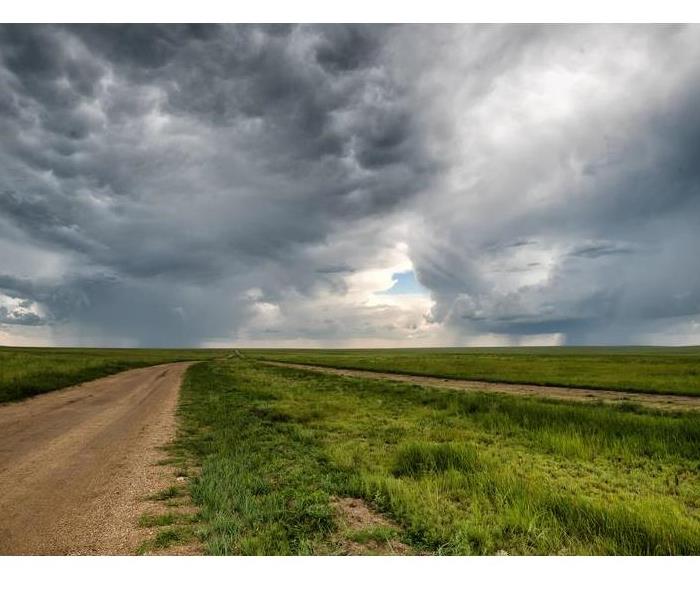 Keep an eye out for summer storms!
Keep an eye out for summer storms!
SERVPRO® of Springfield knows that summer storms can be sudden and devastating. The first step to being prepared for a tornado or any other severe storm is to build a Ready Kit with food, water and other supplies to last at least 3 days. A ready kit can include:
- Water - one gallon of water per person per day for at least three days, for drinking and sanitation
- Food - at least a three-day supply of non-perishable food
- Battery-powered or hand crank radio and a NOAA Weather Radio with tone alert
- Flashlight
- First aid kit
- Extra batteries
- Whistle to signal for help
- Dust mask to help filter contaminated air and plastic sheeting and duct tape to shelter-in-place
- Moist towelettes, garbage bags and plastic ties for personal sanitation
- Wrench or pliers to turn off utilities
- Manual can opener for food
- Local maps
- Cell phone with chargers and a backup battery
Remember SERVPRO® of Springfield is ready to help with any size disaster. Call us 24/7 at 217-528-7775.
Source: www.ready.gov
Flooding is a Real Threat!
7/16/2018 (Permalink)
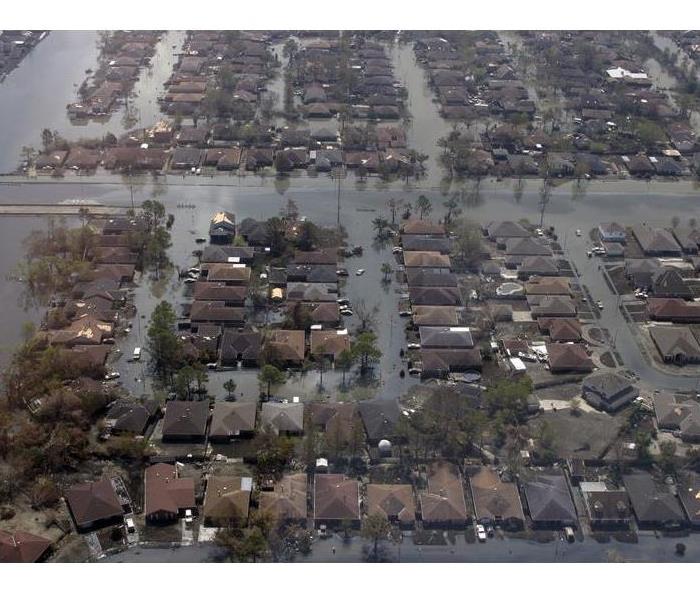 Area flooding is a real threat!
Area flooding is a real threat!
We at SERVPRO® of Springfield would like to take a moment to talk about flooding. Floods are the single most deadly natural disaster in the United States. They are indiscriminate and occur in every state and territory. More dramatic flooding occurs in densely populated areas as construction of buildings, driveways, and roadways create runoff. The water is unable to seep into the ground and as a result can surge through properties without hesitation. Underpasses, underground parking garages and basements can become danger zones very quickly during a flood event.
This does not mean that rural areas are safe from the dangers of flooding. Very intense or prolonged rains in these areas can saturate the soil causing flash floods. Mountains and steep hills can produce heavy rain runoff that can lead to flooding. And embankments along rivers and streams can overflow. Always be sure to keep an eye and ear out for warnings when rains become heavy.
Terms to look out for:
FLASH FLOOD or FLOOD WATCH:
Flash flooding or flooding is possible within the designated watch area - be alert.
FLASH FLOOD or FLOOD WARNING:
Flash flooding or flooding has been reported or is imminent - take necessary precautions at once! Get to higher ground!
URBAN and SMALL STREAM ADVISORY:
Flooding of small streams, streets and low-lying areas, such as railroad underpasses and urban storm drains is occurring.
FLASH FLOOD or FLOOD STATEMENT:
Follow-up information regarding a flash flood/flood event.
If a flood does occur, stay safe! Remember that SERVPRO® of Springfield is here to help with the clean up process. Call us at 217-528-7775 24/7.
Staying Safe During a Lightning Storm with Tips from SERVPRO® of Springfield
5/23/2018 (Permalink)
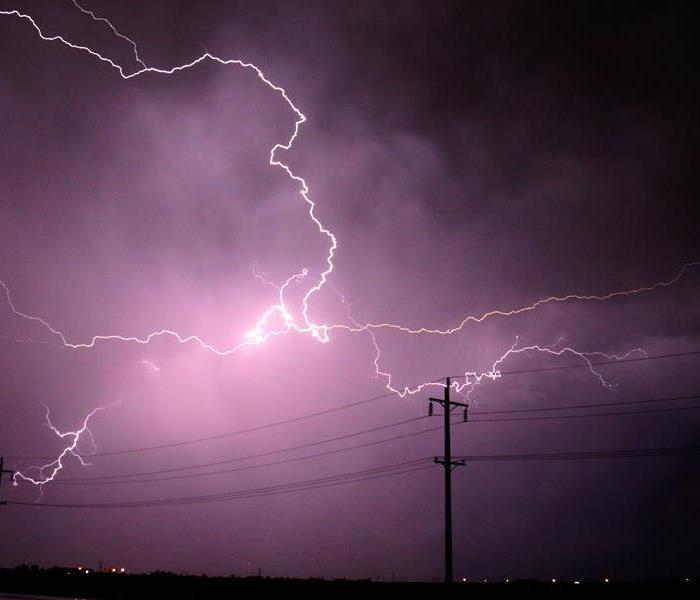 Lightning is as beautiful as it is dangerous.
Lightning is as beautiful as it is dangerous.
We are on the cusp of storm season here in Springfield, IL and we at SERVPRO® of Springfield would like to pass along these safety tips from the National Fire Protection Agency.
- If you can hear thunder, you are within striking distance of lightning. Look for shelter inside a home, large building, or a hard-topped vehicle right away.
- Do not go under trees for shelter. There is no place outside that is safe during a thunderstorm.
- Wait at least 30 minutes after hearing the last clap of thunder before leaving your shelter.
- Stay away from windows and doors. Stay off porches.
- There is no safe place outside. Places with only a roof on sports fields, golf courses, and picnic areas are not safe during a lightning storm. Small sheds should not be used.
- If a person is struck by lightning, call 9-1-1. Get medical help right away.
- Turn off computers. Stay off corded phones, computers, and other things that put you in direct contact with electricity or plumbing. You can use a cell or cordless phone.
Stay safe this Spring and remember SERVPRO® of Springfield is always here to help. Call us at 217-528-7775 24/7.
Source: www.nfpa.org
Winter Storm Checklist
1/1/2018 (Permalink)
Winter storms can range from a moderate snow over a few hours to a blizzard with blinding, winddriven snow that lasts for several days. Some winter storms are large enough to affect several states, while others affect only a single community. Many winter storms are accompanied by dangerously low temperatures and sometimes by strong winds, icing, sleet and freezing rain.
- Source: American Red Cross
Being prepared for winter storms can help limit the damage done and make sure that everyone stays safe before, during, and after. Preparedness may not always be able to prevent damage done by the storm but many times it can make a big difference on how much is damaged.
Follow the link to find the "Winter Storm Safety Checklist" the American Red Cross has put together to help educate about what to expect and what to do in a winter storm situation.
Be Prepared for Winter Storms
12/1/2017 (Permalink)
Winter storms can be just as damaging to homes as any other. The American Red Cross offers the following guidelines to help be prepared for them:
- Learn how to protect pipes from freezing
- Make sure your home heating sources are installed according to local codes and permit requirements and are clean and in working order.
- Make sure your home is properly insulated. Caulk and weather-strip doors and windowsills to keep cold air out.
- Install storm windows or cover windows with plastic from the inside to provide an extra layer of insulation to keep cold air out.
- Consider buying emergency heating equipment, such as a wood- or coal-burning stove or an electric or kerosene heater.
- Stoves must be properly vented and in good working order. Dispose of ashes safely. Keep a supply of wood or coal on hand.
- Electric space heaters, either portable or fixed, must be certified by an independent testing laboratory. Plug a heater directly into the wall socket rather than using an extension cord and unplug it when it is not in use.
- Use a kerosene heater only if permitted by law in your area; check with your local fire department. Use only the correct fuel for your unit. Properly ventilate the area. Refuel the unit outdoors only, and only when the unit is cool. Follow all of the manufacturer's instructions.
- Consider storing sufficient heating fuel. Regular fuel sources may be cut off. Be cautious of fire hazards when storing any type of fuel.
- If you have a fireplace, consider keeping a supply of firewood or coal. Be sure the fireplace is properly vented and in good working order and that you dispose of ashes safely.
- Consider installing a portable generator, following our safety tips to avoid home fires and carbon monoxide poisoning
- Consider purchasing flood insurance, if you live in a flood-prone area, to cover possible flood damage that may occur during the spring thaw. Homeowners' policies do not cover damage from floods. Ask your insurance agent about the National Flood Insurance Program (NFIP) if you are at risk. More information on NFIP is available at www.fema.gov/nfip.
- Source: American Red Cross
Storm Damage Springfield IL
9/18/2017 (Permalink)
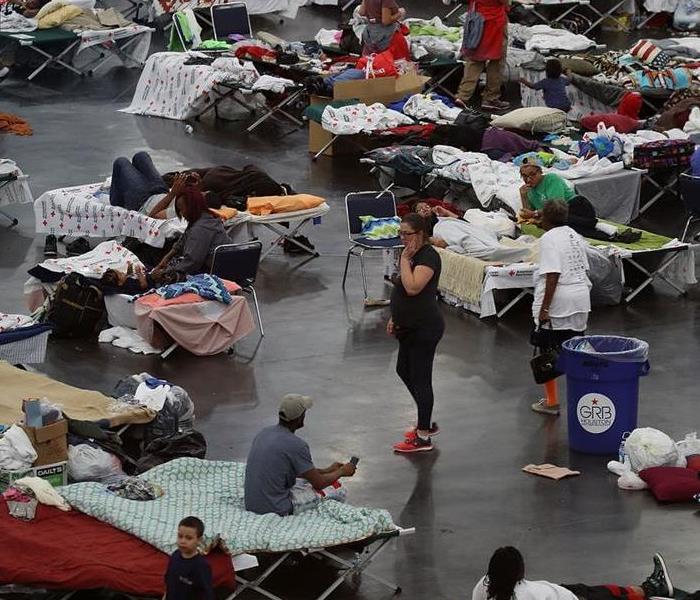 Stay alert for the unexpected
Stay alert for the unexpected
The word storm certainly has been in the news lately. In fact Harvey's remnants were felt all the way up into the state of Illinois. Many homeowners wonder what can be done to prepare for a storm event in the Springfield IL area.
The local planning commission is able to provide you with information about whether or not you are living in flood zone or not here is a link to get you started http://co.sangamon.il.us/departments/m-r/regional-planning-commission/program-areas/strategic-comprehensive-planning
Home Inspection
Something else that can be helpful is to do a walk around of your home. If you have a ladder than start with safely examining the roof looking for loose shingles and siding, then examine all the other areas of the home. This inspection should also include the interior of your home, do you see damage form previous heavy rains? Are electrical services up to date and in good working order? Do you know where the shut offs for all of your utilities are locates and have the tools needed to turn them off?
Stay Alert
Most people today have access to social media and TV and or radio. Please don"t develop warning fatigue! That means that you hear warnings but because nothing happens your state of readiness lessens. Storms in the Springfield IL area develop quickly please stay alert
Storm Damage Springfield IL
9/18/2017 (Permalink)
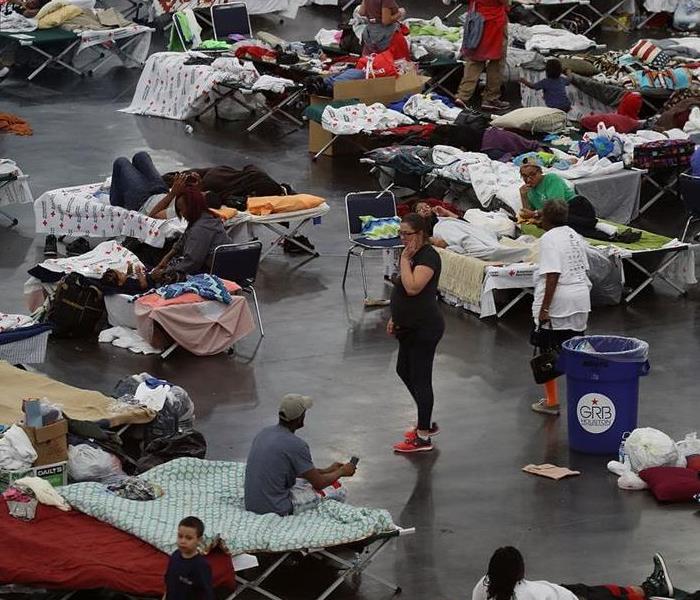 Be ready for the unexpected.
Be ready for the unexpected.
The word storm certainly has been in the news lately. In fact Harvey's remnants were felt all the way up into the state of Illinois. Many homeowners wonder what can be done to prepare for a storm event in the Sangamon County area.
The local planning commission is able to provide you with information about whether or not you are living in flood zone or not here is a link to get you started http://co.sangamon.il.us/departments/m-r/regional-planning-commission/program-areas/strategic-comprehensive-planning
Home Inspection
Something else that can be helpful is to do a walk around of your home. If you have a ladder than start with safely examining the roof looking for loose shingles and siding, then examine all the other areas of the home. This inspection should also include the interior of your home, do you see damage form previous heavy rains? Are electrical services up to date and in good working order? Do you know where the shut offs for all of your utilities are locates and have the tools needed to turn them off?
Stay Alert
Most people today have access to social media and TV and or radio. Please don"t develop warning fatigue! That means that you hear warnings but because nothing happens your state of readiness lessens. Storms in the Sangamon County area develop quickly please stay alert
Hurricane Season
9/18/2017 (Permalink)
Hurricane season is currently underway. For the Atlantic, the season begins June 1 and runs through November 30. The Eastern Pacific hurricane season began in mid-May and also ends November 30.
Hurricanes can be life-threatening as well as cause serious property-threatening hazards such as flooding, storm surge, high winds, and tornadoes. While the primary threat is in coastal areas, many inland areas can also be affected by these hazards, as well as by secondary events such as power outages as a result of high winds and landslides due to rainfall.
Preparation is the best protections against the dangers of a hurricane. Plan an evacuation route and your emergency plan, take inventory of your property, and take steps to protect your home or business.
DID YOU KNOW?
- About 40% of hurricanes hit Florida.
- 2004's Hurricane Ivan produced 127 tornadoes in nine different states over a five-day period.
- To identify these storms, the World Meteorological Organization maintains a six-year rotating list of names.
For more information and preparation tips, visit the READY campaign website at www.ready.gov/hurricanes.
Weather Ready
9/18/2017 (Permalink)
 If you stay ready you don't have to get ready.
If you stay ready you don't have to get ready.
As hurricane season progresses it is a good idea to keep up with programs and social media tools that can keep you up to date with storm updates.
Weather Ready
SERVPRO of Sangamon County has joined forces with the National Weather Services weather ambassador program. What does this mean?
WRN Ambassadors serve a pivotal role in affecting societal change — helping to build a nation that is ready, responsive, and resilient to the impacts of extreme weather and water events.
To be officially recognized as a WRN Ambassador, an organization must commit to:
- Promoting Weather-Ready Nation messages and themes to their stakeholders;
- Engaging with NOAA personnel on potential collaboration opportunities;
- Sharing their success stories of preparedness and resiliency;
- Serving as an example by educating employees on workplace preparedness
As we continue educating ourselves we will be sharing what we learn from the National Weather Service with our customers, please check our Facebook page for weather updates and helpful information before during and after storms and Weather events.
Early Awareness
One vital aspect of the Weather Ambassador program is to promote disaster preparedness. We encourage the public to have a disaster readiness plan including a go bag, designated meting place and to maintain a general reediness so that you not caught of guard.
How to be ready for a thunderstorm
8/22/2017 (Permalink)
The American Red Cross created a great outline of how to prepare for severe thunderstorms. In the case of an emergency it always helps to be prepared.
- Learn about your local community’s emergency warning system for severe thunderstorms
- Discuss thunderstorm safety and lightning safety with all members of your household
- Pick a safe place in your home for household members to gather during a thunderstorm This should be away from windows, skylights and glass doors that could be broken by strong winds or hail
- Make a list of items to bring inside in the event of a severe thunderstorm
- Make trees and shrubbery more wind resistant by keeping them trimmed and removing damaged branches
- Protect your animals by ensuring that any outside buildings that house them are protected in the same way as your home
- Consult your local fire department if you are considering installing lightning rods
- Get trained in first aid and learn how to respond to emergencies
- Put together an emergency preparedness kit
- Review the Be Red Cross Ready - Thunderstorm Safety Checklist
-Source: American Red Cross
Preventing water from entering through window wells
8/10/2017 (Permalink)
Fixing (or preventing) a window well filling with water is all about two components of the window well system – the drain and the cover.
Window Well Drain – Every window well should have a drain to allow water to exit the window well and not build to a level that creates a basement seepage problem. Drains can be connected to interior or exterior drain tile or can be run to daylight where a proper slope exists. With a well-constructed and properly maintained drain, a window well should never fill with water.
Of course, some home builders will take short cuts with window wells and install them without drains. More commonly, though, the drains are there but, because of lack of maintenance, they clog up.
So, one way to fix a window well that is filling with water is to find and unclog the drain. Cleaning debris from the opening to the drain is usually a fairly easy task but, if the drain has become clogged below the surface it can be difficult to unclog. The best way, of course to deal with a clogged window well drain is to prevent it from clogging in the first place by installing a proper window well cover.
Window Well Covers – The most important function of a window well cover is not keeping out water but keeping out the kind of debris – leaves, grass clippings, trash – that will clog the drain. Many homeowners make the understandable mistake of installing flimsy plastic “bubble” covers from the hardware store thinking that they will keep out water. While still intact these covers create a surprisingly efficient greenhouse for weeds but are easily cracked and broken, rendering them useless.
A steel grid cover is better but can still admit a lot of debris.
The best window well cover will be constructed of reinforced polycarbonate and will be custom-fitted to the window well to ensure that it covers it completely. This type of cover, while incidentally preventing most water from entering, will do an excellent job of keeping out debris (and small animals) and keeping the window well drain open and working.
-Source: U.S. Waterproofing
Weather Ready Nation
8/8/2017 (Permalink)
SERVPRO of Springfield has recently become a Weather Ready Nation Ambassador!
The devastating impacts of extreme events like record breaking snowfall, violent tornadoes, destructive hurricanes, widespread flooding, and devastating drought can be reduced by taking advanced action, which is why the Weather–Ready Nation initiative is so important.
The National Oceanic and Atmospheric Administration's (NOAA) National Weather Service is transforming its operations to help America respond. Offices now provide forecast information in a way that better supports emergency managers, first responders, government officials, businesses and the public make fast, smart decisions to save lives and property and enhance livelihoods.
NOAA’s Office of Oceanic and Atmospheric Research and National Environmental Satellite, Data, and Information Service are moving new science and technology into National Weather Service operations that will improve forecasts and ultimately increase weather-readiness.
-Source: weather.gov
No Job Too Large
7/18/2017 (Permalink)
The SERVPRO Commercial Large Loss Division is composed of our best of the best in restoration. Our elite large-loss specialists are prequalified and strategically positioned throughout the United States to handle any size disaster.
Every large loss is supervised by a commercial operations manager to help ensure seamless communication and timely mitigation.
At SERVPRO, the difference is our ability to dispatch trained production professionals and cut costs through the strategic placement and oversight of temporary labor. Get the professionals, call SERVPRO.
Clients for the Commercial Large Loss program include the following:
- The Hospitality Industry
- Property Managers
- Universities
- Municipalities
- The Pentagon
Our teams are ready for anything with the equipment and expertise to tackle any size job.
Should a storm or major event strike, call 217-528-7775





 24/7 Emergency Service
24/7 Emergency Service